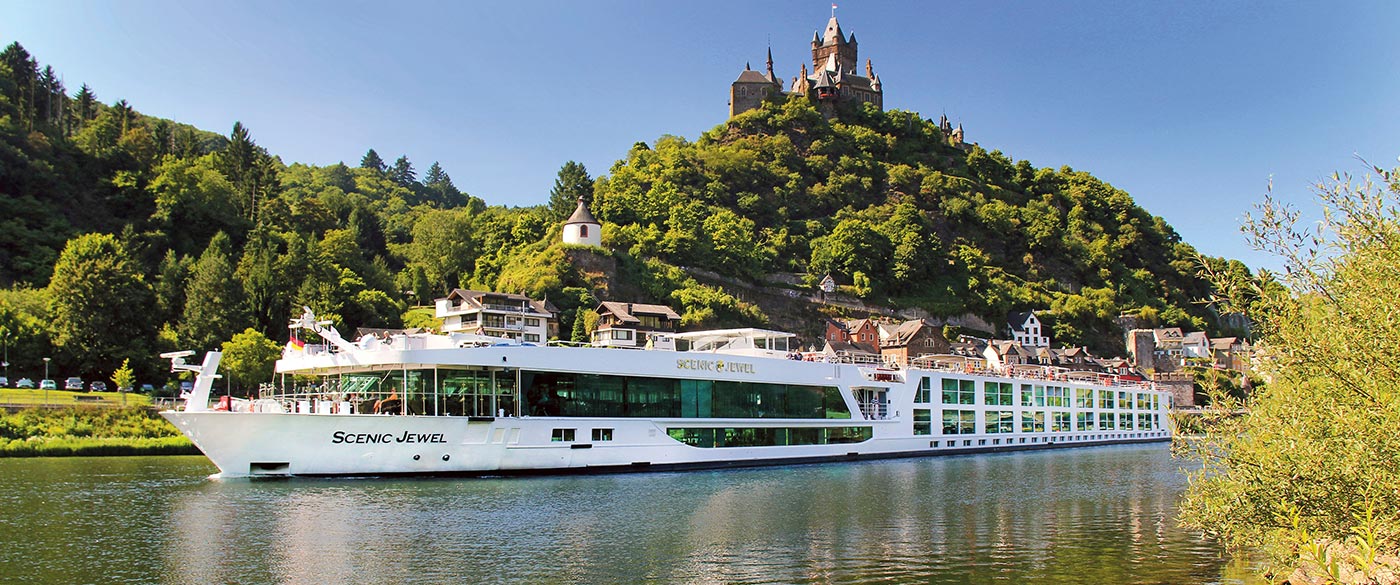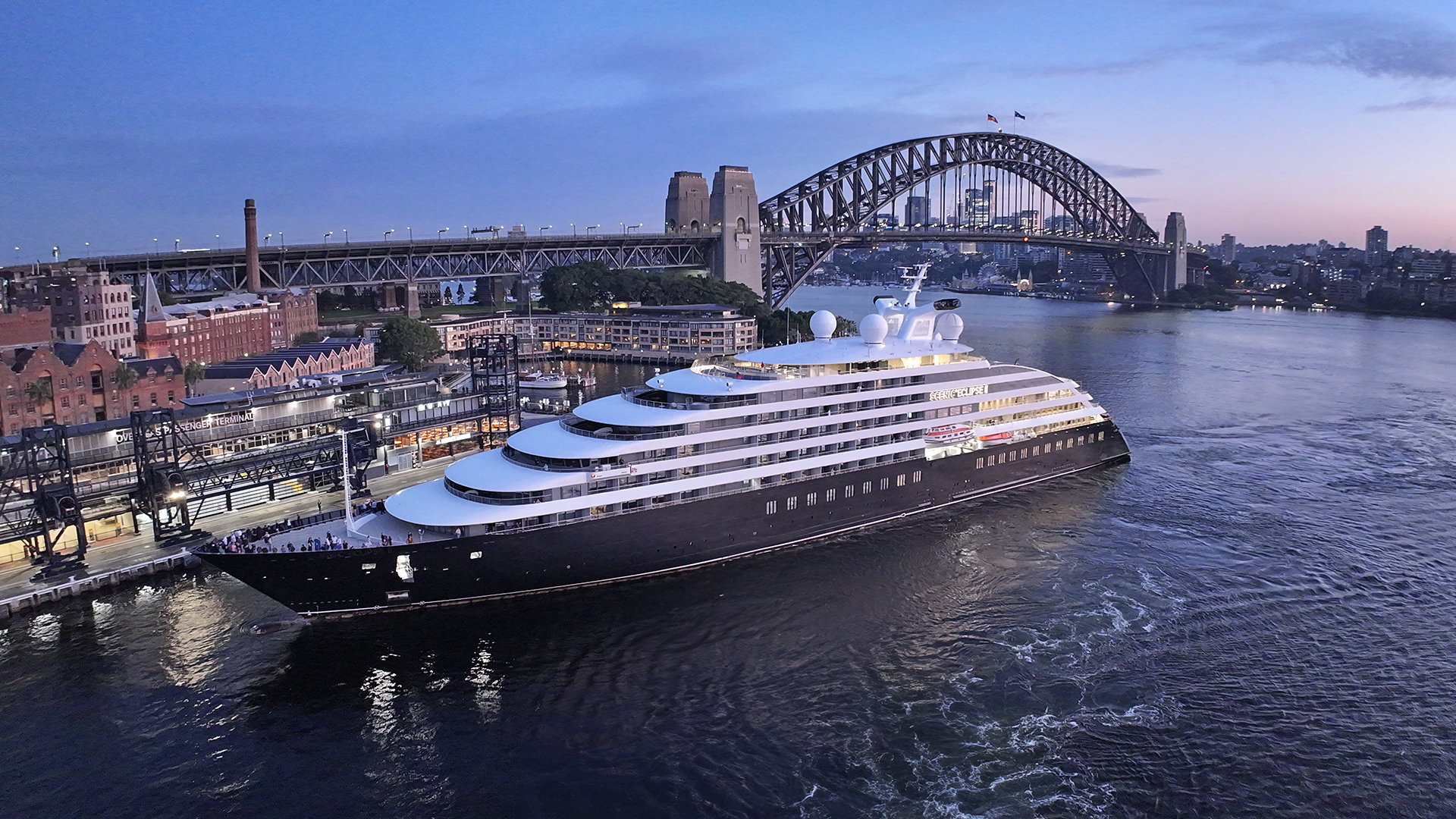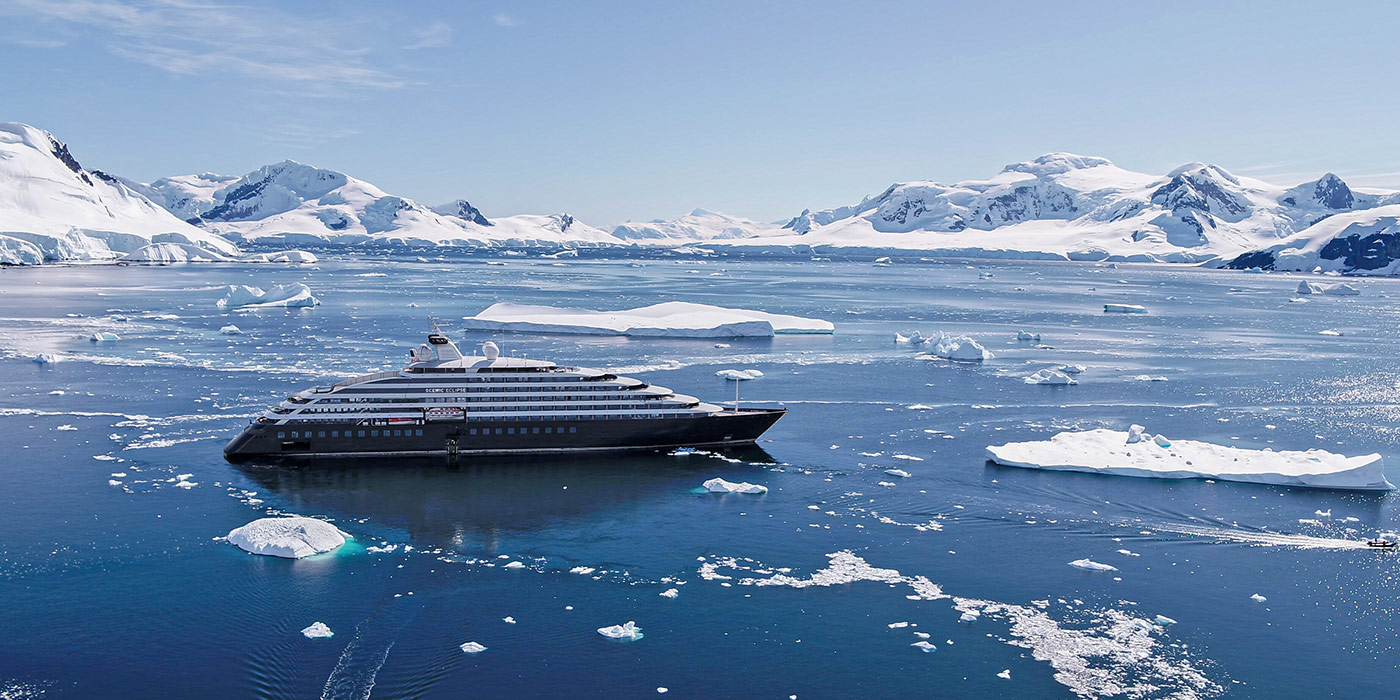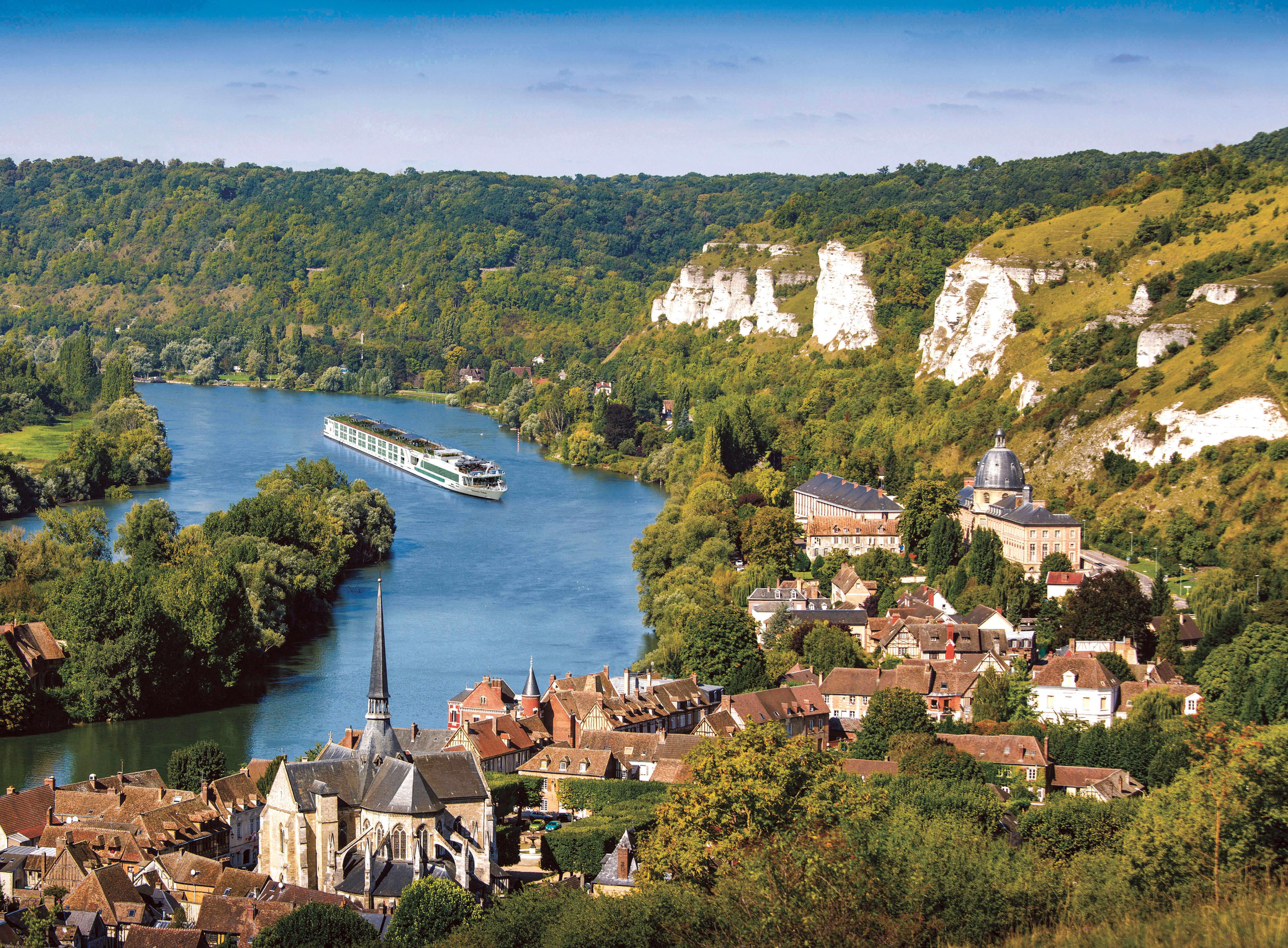Itinerary
Dublin is making a comeback. The decade-long “Celtic Tiger” boom era was quickly followed by the Great Recession, but The Recovery has finally taken a precarious hold. For visitors, this newer and wiser Dublin has become one of western Europe’s most popular and delightful urban destinations. Whether or not you’re out to enjoy the old or new Dublin, you’ll find it a colossally entertaining city, all the more astonishing considering its intimate size.It is ironic and telling that James Joyce chose Dublin as the setting for his famous Ulysses, Dubliners, and A Portrait of the Artist as a Young Man because it was a “center of paralysis” where nothing much ever changed. Which only proves that even the greats get it wrong sometimes. Indeed, if Joyce were to return to his once-genteel hometown today—disappointed with the city’s provincial outlook, he left it in 1902 at the age of 20—and take a quasi-Homeric odyssey through the city (as he so famously does in Ulysses), would he even recognize Dublin as his “Dear Dirty Dumpling, foostherfather of fingalls and dotthergills”?For instance, what would he make of Temple Bar—the city’s erstwhile down-at-the-heels neighborhood, now crammed with cafés and trendy hotels and suffused with a nonstop, international-party atmosphere? Or the simple sophistication of the open-air restaurants of the tiny Italian Quarter (named Quartier Bloom after his own creation), complete with sultry tango lessons? Or of the hot–cool Irishness, where every aspect of Celtic culture results in sold-out theaters, from Once, the cult indie movie and Broadway hit, to Riverdance, the old Irish mass-jig recast as a Las Vegas extravaganza? Plus, the resurrected Joyce might be stirred by the songs of Hozier, fired up by the sultry acting of Michael Fassbender, and moved by the award-winning novels of Colum McCann. As for Ireland’s capital, it’s packed with elegant shops and hotels, theaters, galleries, coffeehouses, and a stunning variety of new, creative little restaurants can be found on almost every street in Dublin, transforming the provincial city that suffocated Joyce into a place almost as cosmopolitan as the Paris to which he fled. And the locals are a hell of a lot more fun! Now that the economy has finally turned a corner, Dublin citizens can cast a cool eye over the last 20 crazy years. Some argue that the boomtown transformation of their heretofore-tranquil city has permanently affected its spirit and character. These skeptics (skepticism long being a favorite pastime in the capital city) await the outcome of “Dublin: The Sequel,” and their greatest fear is the possibility that the tattered old lady on the Liffey has become a little less unique, a little more like everywhere else.Oh ye of little faith: the rare ole gem that is Dublin is far from buried. The fundamentals—the Georgian elegance of Merrion Square, the Norman drama of Christ Church Cathedral, the foamy pint at an atmospheric pub—are still on hand to gratify. Most of all, there are the locals themselves: the nod and grin when you catch their eye on the street, the eagerness to hear half your life story before they tell you all of theirs, and their paradoxically dark but warm sense of humor. It’s expected that 2016 will be an extra-special year in the capital, as centenary celebrations of the fateful 1916 Easter Rising will dominate much of the cultural calendar.
Day programme:
Start your journey in the heart of Dublin, Ireland’s vibrant capital, with a two-night Special Stay.Set on the banks of the River Liffey, Dublin was founded by the Vikings who named the city Dubh Linn, which means ‘Black Pool’ after the tidal pool that formed where the River Poddle met the Liffey. The city is magnificent with Georgian architecture, grand squares and historic monuments, and is steeped in culture and oozes charisma with a touch of hedonism.
Dublin is making a comeback. The decade-long “Celtic Tiger” boom era was quickly followed by the Great Recession, but The Recovery has finally taken a precarious hold. For visitors, this newer and wiser Dublin has become one of western Europe’s most popular and delightful urban destinations. Whether or not you’re out to enjoy the old or new Dublin, you’ll find it a colossally entertaining city, all the more astonishing considering its intimate size.It is ironic and telling that James Joyce chose Dublin as the setting for his famous Ulysses, Dubliners, and A Portrait of the Artist as a Young Man because it was a “center of paralysis” where nothing much ever changed. Which only proves that even the greats get it wrong sometimes. Indeed, if Joyce were to return to his once-genteel hometown today—disappointed with the city’s provincial outlook, he left it in 1902 at the age of 20—and take a quasi-Homeric odyssey through the city (as he so famously does in Ulysses), would he even recognize Dublin as his “Dear Dirty Dumpling, foostherfather of fingalls and dotthergills”?For instance, what would he make of Temple Bar—the city’s erstwhile down-at-the-heels neighborhood, now crammed with cafés and trendy hotels and suffused with a nonstop, international-party atmosphere? Or the simple sophistication of the open-air restaurants of the tiny Italian Quarter (named Quartier Bloom after his own creation), complete with sultry tango lessons? Or of the hot–cool Irishness, where every aspect of Celtic culture results in sold-out theaters, from Once, the cult indie movie and Broadway hit, to Riverdance, the old Irish mass-jig recast as a Las Vegas extravaganza? Plus, the resurrected Joyce might be stirred by the songs of Hozier, fired up by the sultry acting of Michael Fassbender, and moved by the award-winning novels of Colum McCann. As for Ireland’s capital, it’s packed with elegant shops and hotels, theaters, galleries, coffeehouses, and a stunning variety of new, creative little restaurants can be found on almost every street in Dublin, transforming the provincial city that suffocated Joyce into a place almost as cosmopolitan as the Paris to which he fled. And the locals are a hell of a lot more fun! Now that the economy has finally turned a corner, Dublin citizens can cast a cool eye over the last 20 crazy years. Some argue that the boomtown transformation of their heretofore-tranquil city has permanently affected its spirit and character. These skeptics (skepticism long being a favorite pastime in the capital city) await the outcome of “Dublin: The Sequel,” and their greatest fear is the possibility that the tattered old lady on the Liffey has become a little less unique, a little more like everywhere else.Oh ye of little faith: the rare ole gem that is Dublin is far from buried. The fundamentals—the Georgian elegance of Merrion Square, the Norman drama of Christ Church Cathedral, the foamy pint at an atmospheric pub—are still on hand to gratify. Most of all, there are the locals themselves: the nod and grin when you catch their eye on the street, the eagerness to hear half your life story before they tell you all of theirs, and their paradoxically dark but warm sense of humor. It’s expected that 2016 will be an extra-special year in the capital, as centenary celebrations of the fateful 1916 Easter Rising will dominate much of the cultural calendar.
Day programme:
This morning your local guide will help you discover the history and charm of Dublin on a walking tour. See The Mansion House, the official residence of Dublin’s Lord Mayor, Dublin Castle, which was constructed in the 13th century on the site of a Viking settlement, and the old Post Office, the heart of Dublin’s history and culture for more than 800 years. You will also see 19th century Fitzwilliam Square, St. Stephen’s Green Park, the Molly Malone statue, the Old Parliament House and City Hall. Scenic Freechoice: Choose from these captivating Freechoice activities.Guinness Storehouse: Visit the Guinness Storehouse and factory to learn how this famous brew is made. After your guided tour, learn how to pull the perfect pint and enjoy a tasting from the 7th floor, which has a spectacular vantage point overlooking the city of Dublin.Historical Ireland: Discover Dublin’s fascinating past on a guided tour: learn about the Irish Revolution, ‘the Irish War of Independence’, a decade long conflict between the British state and Irish republican guerrillas and visit the EPIC – The Irish Emigration Museum to gain a deep understanding of what it means to be Irish.
Dublin is making a comeback. The decade-long “Celtic Tiger” boom era was quickly followed by the Great Recession, but The Recovery has finally taken a precarious hold. For visitors, this newer and wiser Dublin has become one of western Europe’s most popular and delightful urban destinations. Whether or not you’re out to enjoy the old or new Dublin, you’ll find it a colossally entertaining city, all the more astonishing considering its intimate size.It is ironic and telling that James Joyce chose Dublin as the setting for his famous Ulysses, Dubliners, and A Portrait of the Artist as a Young Man because it was a “center of paralysis” where nothing much ever changed. Which only proves that even the greats get it wrong sometimes. Indeed, if Joyce were to return to his once-genteel hometown today—disappointed with the city’s provincial outlook, he left it in 1902 at the age of 20—and take a quasi-Homeric odyssey through the city (as he so famously does in Ulysses), would he even recognize Dublin as his “Dear Dirty Dumpling, foostherfather of fingalls and dotthergills”?For instance, what would he make of Temple Bar—the city’s erstwhile down-at-the-heels neighborhood, now crammed with cafés and trendy hotels and suffused with a nonstop, international-party atmosphere? Or the simple sophistication of the open-air restaurants of the tiny Italian Quarter (named Quartier Bloom after his own creation), complete with sultry tango lessons? Or of the hot–cool Irishness, where every aspect of Celtic culture results in sold-out theaters, from Once, the cult indie movie and Broadway hit, to Riverdance, the old Irish mass-jig recast as a Las Vegas extravaganza? Plus, the resurrected Joyce might be stirred by the songs of Hozier, fired up by the sultry acting of Michael Fassbender, and moved by the award-winning novels of Colum McCann. As for Ireland’s capital, it’s packed with elegant shops and hotels, theaters, galleries, coffeehouses, and a stunning variety of new, creative little restaurants can be found on almost every street in Dublin, transforming the provincial city that suffocated Joyce into a place almost as cosmopolitan as the Paris to which he fled. And the locals are a hell of a lot more fun! Now that the economy has finally turned a corner, Dublin citizens can cast a cool eye over the last 20 crazy years. Some argue that the boomtown transformation of their heretofore-tranquil city has permanently affected its spirit and character. These skeptics (skepticism long being a favorite pastime in the capital city) await the outcome of “Dublin: The Sequel,” and their greatest fear is the possibility that the tattered old lady on the Liffey has become a little less unique, a little more like everywhere else.Oh ye of little faith: the rare ole gem that is Dublin is far from buried. The fundamentals—the Georgian elegance of Merrion Square, the Norman drama of Christ Church Cathedral, the foamy pint at an atmospheric pub—are still on hand to gratify. Most of all, there are the locals themselves: the nod and grin when you catch their eye on the street, the eagerness to hear half your life story before they tell you all of theirs, and their paradoxically dark but warm sense of humor. It’s expected that 2016 will be an extra-special year in the capital, as centenary celebrations of the fateful 1916 Easter Rising will dominate much of the cultural calendar.
Day programme:
Today, you’ll visit the 600-year-old Blarney Castle. Explore the historic castle and see the legendary ‘Stone of Eloquence’, more commonly known as the Blarney Stone. Legend says if you kiss it, you will receive the ‘gift of the gab’. Over the years, famous people such as Sir Winston Churchill, Ronald Reagan and Mick Jagger have puckered up to the ancient stone.Afterwards, continue to Killarney, a charming town nestled in a valley surrounded by Ireland’s highest mountain range, the McGillycuddy Reeks, for a two-night Special Stay.
Day programme:
Today you will experience the breathtaking scenery of the Ring of Kerry, renowned as one of the most picturesque landscapes in Ireland. Here, the Iveragh Mountains dramatically drop into the Atlantic Ocean, where rolling green hills dotted with cows and sheep, are punctuated by sparkling lakes, grand houses and ancient castles. Watch as tiny fishing villages and off-shore islands come in and out of view as you wind along this 100-kilometre route, which will captivate you at every bend.
Day programme:
Today, you will drive along the spectacular Wild Atlantic Way to the Cliffs of Moher, a wind-whipped geological wonder that stretch for eight kilometres and soar to 214 metres above the crashing sea below.Arrive in the vibrant city of Galway for an overnight Special Stay. The only city along the entire 2,500-kilometre Wild Atlantic Way, Galway is a remote, bohemian city that is rich in creative culture. Its cobbled streets are lined with candy-coloured shopfronts, cafes and bars, which serve exceptional Irish food and are alive with traditional music.
Galway is a city in the West of Ireland in the province of Connacht. It lies on the River Corrib between Lough Corrib and Galway Bay and is surrounded by County Galway. It is the fourth most populous urban area in the Republic of Ireland and the sixth most populous city in the island of Ireland. It is both a picturesque and lively city with a wonderful avant-garde culture and a fascinating mixture of locally owned speciality shops, often featuring locally made crafts. Indeed local handcrafts are a feature of the entire region including hand knits, pottery, glass, jewellery and woodwork. The city’s hub is 18th-century Eyre Square, a popular meeting spot surrounded by shops, and traditional pubs that often offer live Irish folk music. Nearby, stone-clad cafes, boutiques and art galleries line the winding lanes of the Latin Quarter, which retains portions of the medieval city walls. The city bears the nickname “The City of the Tribes” because “fourteen tribes” of merchant families led the city in its Hiberno-Norman period. The merchants would have seen themselves as Irish gentry and loyal to the King. They later adopted the term as a badge of honour and pride in defiance of the town’s Cromwellian occupier.
Galway is a city in the West of Ireland in the province of Connacht. It lies on the River Corrib between Lough Corrib and Galway Bay and is surrounded by County Galway. It is the fourth most populous urban area in the Republic of Ireland and the sixth most populous city in the island of Ireland. It is both a picturesque and lively city with a wonderful avant-garde culture and a fascinating mixture of locally owned speciality shops, often featuring locally made crafts. Indeed local handcrafts are a feature of the entire region including hand knits, pottery, glass, jewellery and woodwork. The city’s hub is 18th-century Eyre Square, a popular meeting spot surrounded by shops, and traditional pubs that often offer live Irish folk music. Nearby, stone-clad cafes, boutiques and art galleries line the winding lanes of the Latin Quarter, which retains portions of the medieval city walls. The city bears the nickname “The City of the Tribes” because “fourteen tribes” of merchant families led the city in its Hiberno-Norman period. The merchants would have seen themselves as Irish gentry and loyal to the King. They later adopted the term as a badge of honour and pride in defiance of the town’s Cromwellian occupier.
Day programme:
Today you will be making your way to Northern Ireland, stopping enroute to visit the Monastery of Clonmacnoise. Dating to the 6th century, the relics offer a rare insight into life in this period. The site includes the remnants of a cathedral and one of the largest collection of early Christian graves.Continue to Belfast, the capital of Northern Ireland, for a two-night Special Stay. Set on the shores of the Belfast Lough and overlooked by rugged Cave Hill, this lively city is the gateway to the dramatic Causeway Coastal Route and is where the Titanic was built.
Before English and Scottish settlers arrived in the 1600s, Belfast was a tiny village called Béal Feirste (“sandbank ford”) belonging to Ulster’s ancient O’Neill clan. With the advent of the Plantation period (when settlers arrived in the 1600s), Sir Arthur Chichester, from Devon in southwestern England, received the city from the English Crown, and his son was made Earl of Donegall. Huguenots fleeing persecution from France settled near here, bringing their valuable linen-work skills. In the 18th century, Belfast underwent a phenomenal expansion—its population doubled every 10 years, despite an ever-present sectarian divide. Although the Anglican gentry despised the Presbyterian artisans—who, in turn, distrusted the native Catholics—Belfast’s growth continued at a dizzying speed. The city was a great Victorian success story, an industrial boomtown whose prosperity was built on trade, especially linen and shipbuilding. Famously (or infamously), the Titanic was built here, giving Belfast, for a time, the nickname “Titanic Town.” Having laid the foundation stone of the city’s university in 1845, Queen Victoria returned to Belfast in 1849 (she is recalled in the names of buildings, streets, bars, monuments, and other places around the city), and in the same year, the university opened under the name Queen’s College. Nearly 40 years later, in 1888, Victoria granted Belfast its city charter. Today its population is nearly 300,000, tourist numbers have increased, and this dramatically transformed city is enjoying an unparalleled renaissance.This is all a welcome change from the period when news about Belfast meant reports about “the Troubles.” Since the 1994 ceasefire, Northern Ireland’s capital city has benefited from major hotel investment, gentrified quaysides (or strands), a sophisticated new performing arts center, and major initiatives to boost tourism. Although the 1996 bombing of offices at Canary Wharf in London disrupted the 1994 peace agreement, the ceasefire was officially reestablished on July 20, 1997, and this embattled city began its quest for a newfound identity.Since 2008, the city has restored all its major public buildings such as museums, churches, theaters, City Hall, Ulster Hall—and even the glorious Crown Bar—spending millions of pounds on its built heritage. A gaol that at the height of the Troubles held some of the most notorious murderers involved in paramilitary violence is now a major visitor attraction.Belfast’s city center is made up of three roughly contiguous areas that are easy to navigate on foot. From the south end to the north, it’s about an hour’s leisurely walk.
Before English and Scottish settlers arrived in the 1600s, Belfast was a tiny village called Béal Feirste (“sandbank ford”) belonging to Ulster’s ancient O’Neill clan. With the advent of the Plantation period (when settlers arrived in the 1600s), Sir Arthur Chichester, from Devon in southwestern England, received the city from the English Crown, and his son was made Earl of Donegall. Huguenots fleeing persecution from France settled near here, bringing their valuable linen-work skills. In the 18th century, Belfast underwent a phenomenal expansion—its population doubled every 10 years, despite an ever-present sectarian divide. Although the Anglican gentry despised the Presbyterian artisans—who, in turn, distrusted the native Catholics—Belfast’s growth continued at a dizzying speed. The city was a great Victorian success story, an industrial boomtown whose prosperity was built on trade, especially linen and shipbuilding. Famously (or infamously), the Titanic was built here, giving Belfast, for a time, the nickname “Titanic Town.” Having laid the foundation stone of the city’s university in 1845, Queen Victoria returned to Belfast in 1849 (she is recalled in the names of buildings, streets, bars, monuments, and other places around the city), and in the same year, the university opened under the name Queen’s College. Nearly 40 years later, in 1888, Victoria granted Belfast its city charter. Today its population is nearly 300,000, tourist numbers have increased, and this dramatically transformed city is enjoying an unparalleled renaissance.This is all a welcome change from the period when news about Belfast meant reports about “the Troubles.” Since the 1994 ceasefire, Northern Ireland’s capital city has benefited from major hotel investment, gentrified quaysides (or strands), a sophisticated new performing arts center, and major initiatives to boost tourism. Although the 1996 bombing of offices at Canary Wharf in London disrupted the 1994 peace agreement, the ceasefire was officially reestablished on July 20, 1997, and this embattled city began its quest for a newfound identity.Since 2008, the city has restored all its major public buildings such as museums, churches, theaters, City Hall, Ulster Hall—and even the glorious Crown Bar—spending millions of pounds on its built heritage. A gaol that at the height of the Troubles held some of the most notorious murderers involved in paramilitary violence is now a major visitor attraction.Belfast’s city center is made up of three roughly contiguous areas that are easy to navigate on foot. From the south end to the north, it’s about an hour’s leisurely walk.
Day programme:
Belfast is a port city with a fascinating history. Learn about its troubled past during a guided tour. Afterwards discover the story of Titanic, from its design and build to its fateful ending. You will have the opportunity to hear some fascinating facts about the great ship and learn about the architectural design from the spot where the ship was launched.
Before English and Scottish settlers arrived in the 1600s, Belfast was a tiny village called Béal Feirste (“sandbank ford”) belonging to Ulster’s ancient O’Neill clan. With the advent of the Plantation period (when settlers arrived in the 1600s), Sir Arthur Chichester, from Devon in southwestern England, received the city from the English Crown, and his son was made Earl of Donegall. Huguenots fleeing persecution from France settled near here, bringing their valuable linen-work skills. In the 18th century, Belfast underwent a phenomenal expansion—its population doubled every 10 years, despite an ever-present sectarian divide. Although the Anglican gentry despised the Presbyterian artisans—who, in turn, distrusted the native Catholics—Belfast’s growth continued at a dizzying speed. The city was a great Victorian success story, an industrial boomtown whose prosperity was built on trade, especially linen and shipbuilding. Famously (or infamously), the Titanic was built here, giving Belfast, for a time, the nickname “Titanic Town.” Having laid the foundation stone of the city’s university in 1845, Queen Victoria returned to Belfast in 1849 (she is recalled in the names of buildings, streets, bars, monuments, and other places around the city), and in the same year, the university opened under the name Queen’s College. Nearly 40 years later, in 1888, Victoria granted Belfast its city charter. Today its population is nearly 300,000, tourist numbers have increased, and this dramatically transformed city is enjoying an unparalleled renaissance.This is all a welcome change from the period when news about Belfast meant reports about “the Troubles.” Since the 1994 ceasefire, Northern Ireland’s capital city has benefited from major hotel investment, gentrified quaysides (or strands), a sophisticated new performing arts center, and major initiatives to boost tourism. Although the 1996 bombing of offices at Canary Wharf in London disrupted the 1994 peace agreement, the ceasefire was officially reestablished on July 20, 1997, and this embattled city began its quest for a newfound identity.Since 2008, the city has restored all its major public buildings such as museums, churches, theaters, City Hall, Ulster Hall—and even the glorious Crown Bar—spending millions of pounds on its built heritage. A gaol that at the height of the Troubles held some of the most notorious murderers involved in paramilitary violence is now a major visitor attraction.Belfast’s city center is made up of three roughly contiguous areas that are easy to navigate on foot. From the south end to the north, it’s about an hour’s leisurely walk.
Day programme:
This morning, cross the Irish Sea by ferry to Scotland, where you will travel to Loch Lomond, one of Scotland’s best-known lakes (loch means lake in Scotland) and the largest in Great Britain by surface area. This evening, check into your hotel for a two-night Special Stay.
Day programme:
Loch Lomond may be known for its breathtaking waterway, but Stirling Castle is one of the region’s most iconic castles. Home to multiple generations of Scottish royalty, including the childhood home of Mary Queen of Scots, its the ancient halls of this castle which possesses a rich storied history. You will see the Great Hall, the largest Medieval banqueting hall ever built in Scotland, and the elaborate Royal Chapel.
Day programme:
Journey to Loch Ness, a corner of the Scottish Highlands that is known for its dramatic scenery and the fabled Loch Ness monster. Keep an eye out for this elusive creature, also known as ‘Nessie’, a large prehistoric reptile believed to be living in the loch. There have been thousands of alleged sightings since the 1930s, including photographs emerging all the time, though there is no scientific evidence that Nessie exists. Nonetheless, the great folklore of the Loch Ness continues to draw in visitors far and wide. Tonight, you’ll enjoy the first of a two-night stay.
Day programme:
Known as Scotland’s Highland Capital, Inverness sits where the River Ness meets the Moray Firth, an inlet of the North Sea. Today you will visit the Battle of Culloden Visitors Centre, where you will learn about the 1745 Jacobite rising and hear tales of the battle that is often described as one of the most brutal in Scottish history. Then you will discover 14th century Cawdor Castle, which is still inhabited by the Cawdor family and comprises a moat, drawbridge, turrets and turnpike stairs.
Day programme:
This morning you will depart the highlands bound for Edinburgh via Scone Palace, the seat of parliaments and the crowning place of Scottish kings including Macbeth, and the capital of the Pict kingdom. Their name is thought to mean ‘the painted ones’, and there is suggestion that they decorated themselves with tattoos and dyed their skin blue. Scenic EnrichIn the palace grounds you will be treated to a delicious morning tea accompanied by an impressive demonstration of Falconry. Known as the 'sport of Kings' this ancient art has a history that dates back almost 4,000 years.Afterwards, continue to Edinburgh, on arrival visit a local distillery to learn how famous Scottish Whiskey is produced. One of the most architecturally beautiful cities in the world, Edinburgh has been Scotland’s capital since the 15th century.
Edinburgh is to London as poetry is to prose, as Charlotte Brontë once wrote. One of the world’s stateliest cities and proudest capitals, it’s built—like Rome—on seven hills, making it a striking backdrop for the ancient pageant of history. In a skyline of sheer drama, Edinburgh Castle watches over the capital city, frowning down on Princes Street’s glamour and glitz. But despite its rich past, the city’s famous festivals, excellent museums and galleries, as well as the modern Scottish Parliament, are reminders that Edinburgh has its feet firmly in the 21st century.Nearly everywhere in Edinburgh (the burgh is always pronounced burra in Scotland) there are spectacular buildings, whose Doric, Ionic, and Corinthian pillars add touches of neoclassical grandeur to the largely Presbyterian backdrop. Large gardens are a strong feature of central Edinburgh, where the city council is one of the most stridently conservationist in Europe. Arthur’s Seat, a mountain of bright green and yellow furze, rears up behind the spires of the Old Town. This child-size mountain jutting 822 feet above its surroundings has steep slopes and little crags, like a miniature Highlands set down in the middle of the busy city. Appropriately, these theatrical elements match Edinburgh’s character—after all, the city has been a stage that has seen its fair share of romance, violence, tragedy, and triumph.Modern Edinburgh has become a cultural capital, staging the Edinburgh International Festival and the Fringe Festival in every possible venue each August. The stunning Museum of Scotland complements the city’s wealth of galleries and artsy hangouts. Add Edinburgh’s growing reputation for food and nightlife and you have one of the world’s most beguiling cities.Today the city is the second most important financial center in the United Kingdom, and the fifth most important in Europe. The city regularly is ranked near the top in quality-of-life surveys. Accordingly, New Town apartments on fashionable streets sell for considerable sums. In some senses the city is showy and materialistic, but Edinburgh still supports learned societies, some of which have their roots in the Scottish Enlightenment. The Royal Society of Edinburgh, for example, established in 1783 “for the advancement of learning and useful knowledge,” remains an important forum for interdisciplinary activities.Even as Edinburgh moves through the 21st century, its tall guardian castle remains the focal point of the city and its venerable history. Take time to explore the streets—peopled by the spirits of Mary, Queen of Scots; Sir Walter Scott; and Robert Louis Stevenson—and pay your respects to the world’s best-loved terrier, Greyfriars Bobby. In the evenings you can enjoy candlelit restaurants or a folk ceilidh (pronounced kay-lee, a traditional Scottish dance with music), though you should remember that you haven’t earned your porridge until you’ve climbed Arthur’s Seat. Should you wander around a corner, say, on George Street, you might see not an endless cityscape, but blue sea and a patchwork of fields. This is the county of Fife, beyond the inlet of the North Sea called the Firth of Forth—a reminder, like the mountains to the northwest that can be glimpsed from Edinburgh’s highest points, that the rest of Scotland lies within easy reach.
Edinburgh is to London as poetry is to prose, as Charlotte Brontë once wrote. One of the world’s stateliest cities and proudest capitals, it’s built—like Rome—on seven hills, making it a striking backdrop for the ancient pageant of history. In a skyline of sheer drama, Edinburgh Castle watches over the capital city, frowning down on Princes Street’s glamour and glitz. But despite its rich past, the city’s famous festivals, excellent museums and galleries, as well as the modern Scottish Parliament, are reminders that Edinburgh has its feet firmly in the 21st century.Nearly everywhere in Edinburgh (the burgh is always pronounced burra in Scotland) there are spectacular buildings, whose Doric, Ionic, and Corinthian pillars add touches of neoclassical grandeur to the largely Presbyterian backdrop. Large gardens are a strong feature of central Edinburgh, where the city council is one of the most stridently conservationist in Europe. Arthur’s Seat, a mountain of bright green and yellow furze, rears up behind the spires of the Old Town. This child-size mountain jutting 822 feet above its surroundings has steep slopes and little crags, like a miniature Highlands set down in the middle of the busy city. Appropriately, these theatrical elements match Edinburgh’s character—after all, the city has been a stage that has seen its fair share of romance, violence, tragedy, and triumph.Modern Edinburgh has become a cultural capital, staging the Edinburgh International Festival and the Fringe Festival in every possible venue each August. The stunning Museum of Scotland complements the city’s wealth of galleries and artsy hangouts. Add Edinburgh’s growing reputation for food and nightlife and you have one of the world’s most beguiling cities.Today the city is the second most important financial center in the United Kingdom, and the fifth most important in Europe. The city regularly is ranked near the top in quality-of-life surveys. Accordingly, New Town apartments on fashionable streets sell for considerable sums. In some senses the city is showy and materialistic, but Edinburgh still supports learned societies, some of which have their roots in the Scottish Enlightenment. The Royal Society of Edinburgh, for example, established in 1783 “for the advancement of learning and useful knowledge,” remains an important forum for interdisciplinary activities.Even as Edinburgh moves through the 21st century, its tall guardian castle remains the focal point of the city and its venerable history. Take time to explore the streets—peopled by the spirits of Mary, Queen of Scots; Sir Walter Scott; and Robert Louis Stevenson—and pay your respects to the world’s best-loved terrier, Greyfriars Bobby. In the evenings you can enjoy candlelit restaurants or a folk ceilidh (pronounced kay-lee, a traditional Scottish dance with music), though you should remember that you haven’t earned your porridge until you’ve climbed Arthur’s Seat. Should you wander around a corner, say, on George Street, you might see not an endless cityscape, but blue sea and a patchwork of fields. This is the county of Fife, beyond the inlet of the North Sea called the Firth of Forth—a reminder, like the mountains to the northwest that can be glimpsed from Edinburgh’s highest points, that the rest of Scotland lies within easy reach.
Day programme:
Explore Edinburgh’s ancient, cobbled streets and well-preserved medieval and classical architecture today during a guided tour. This historic city was founded upon volcanic Castle Rock, where Edinburgh Castle sits today.Enjoy the afternoon at leisure. Perhaps wander down the city’s Royal Mile, buzzing with stores, cafes, bars, and often street performers. This road connects the two royal residences, stretching from Holyrood Palace to Edinburgh Castle.Tonight, you will have the pleasure of witnessing the?Edinburgh Military Tattoo. This annual event is celebrated at Edinburgh Castle and is an artistic performance by British Armed Forces, Commonwealth and international military bands.
Edinburgh is to London as poetry is to prose, as Charlotte Brontë once wrote. One of the world’s stateliest cities and proudest capitals, it’s built—like Rome—on seven hills, making it a striking backdrop for the ancient pageant of history. In a skyline of sheer drama, Edinburgh Castle watches over the capital city, frowning down on Princes Street’s glamour and glitz. But despite its rich past, the city’s famous festivals, excellent museums and galleries, as well as the modern Scottish Parliament, are reminders that Edinburgh has its feet firmly in the 21st century.Nearly everywhere in Edinburgh (the burgh is always pronounced burra in Scotland) there are spectacular buildings, whose Doric, Ionic, and Corinthian pillars add touches of neoclassical grandeur to the largely Presbyterian backdrop. Large gardens are a strong feature of central Edinburgh, where the city council is one of the most stridently conservationist in Europe. Arthur’s Seat, a mountain of bright green and yellow furze, rears up behind the spires of the Old Town. This child-size mountain jutting 822 feet above its surroundings has steep slopes and little crags, like a miniature Highlands set down in the middle of the busy city. Appropriately, these theatrical elements match Edinburgh’s character—after all, the city has been a stage that has seen its fair share of romance, violence, tragedy, and triumph.Modern Edinburgh has become a cultural capital, staging the Edinburgh International Festival and the Fringe Festival in every possible venue each August. The stunning Museum of Scotland complements the city’s wealth of galleries and artsy hangouts. Add Edinburgh’s growing reputation for food and nightlife and you have one of the world’s most beguiling cities.Today the city is the second most important financial center in the United Kingdom, and the fifth most important in Europe. The city regularly is ranked near the top in quality-of-life surveys. Accordingly, New Town apartments on fashionable streets sell for considerable sums. In some senses the city is showy and materialistic, but Edinburgh still supports learned societies, some of which have their roots in the Scottish Enlightenment. The Royal Society of Edinburgh, for example, established in 1783 “for the advancement of learning and useful knowledge,” remains an important forum for interdisciplinary activities.Even as Edinburgh moves through the 21st century, its tall guardian castle remains the focal point of the city and its venerable history. Take time to explore the streets—peopled by the spirits of Mary, Queen of Scots; Sir Walter Scott; and Robert Louis Stevenson—and pay your respects to the world’s best-loved terrier, Greyfriars Bobby. In the evenings you can enjoy candlelit restaurants or a folk ceilidh (pronounced kay-lee, a traditional Scottish dance with music), though you should remember that you haven’t earned your porridge until you’ve climbed Arthur’s Seat. Should you wander around a corner, say, on George Street, you might see not an endless cityscape, but blue sea and a patchwork of fields. This is the county of Fife, beyond the inlet of the North Sea called the Firth of Forth—a reminder, like the mountains to the northwest that can be glimpsed from Edinburgh’s highest points, that the rest of Scotland lies within easy reach.
Day programme:
This morning you’ll depart Edinburgh on a scenic drive to Alnwick Castle. There, you’ll discover an incredible history that dates back over 950 years to the Norman period. Learn about the family that has resided in the castle for over 700 years and hear about the movies that have used Alnwick as a filming location, including Harry Potter and Downton Abbey.Arrive in York this afternoon. This fascinating Medieval city is nestled within ancient city walls and has Roman and Viking roots. Tonight, check in for a two-night Special Stay.
Day programme:
This morning you will meet a local guide who will escort you through this delightful city seeing all the Roman and Viking heritage that is on offer. Walk along The Shambles, the narrow medieval street lined with half-timbered houses and traditional shop fronts and see the impressive York Minster, said to be one of the most beautiful gothic churches in the world.
Day programme:
Enroute to the Roman city of Bath, you will stop in the charming town of Stratford-upon-Avon, the birthplace of William Shakespeare. Enjoy an orientation tour to see where the famous Bard was born, learn about his life and see his final resting place. This afternoon you’ll arrive in Bath and check into your hotel for a two-night Special Stay. The city of Bath has been a spa town since Roman times thanks to the mineral waters with restorative properties that bubble beneath its surface. It was also the home of Jane Austen and was frequented by Charles Dickens.
Day programme:
Discover beautiful Bath on a guided walking tour. The UK’s only World Heritage-listed city, the town is resplendent in honey-coloured Georgian architecture, stately Palladian townhouses and the renowned Roman Baths, constructed in 70AD.This afternoon is at leisure to explore the city at your own pace. Perhaps you would like to pack your swimsuit and make your way to the contemporary Thermae Bath Spa to experience the therapeutic waters that make this city world famous or climb the 212 steps to the top of Abbey Tower for a panoramic view over the ancient city and surrounding countryside.
Day programme:
On your way to London, you’ll discover the mystical wonders of Stonehenge. It is estimated that this World Heritage site is around 5,000 years old. See the Stone Circle, neolithic villages and learn more at the exhibition. Afterwards, continue to the English capital, London, for a two-night Special Stay. The city features some of the most recognisable historic landmarks in the world, including Big Ben, the Tower of London, Westminster Abbey and Buckingham Palace. Among London’s 2,000-year history, you’ll find bustling pubs, the West End theatre district and the glorious River Thames at its heart.
About 8 miles downstream—which means seaward, to the east—from central London, Greenwich is a small borough that looms large across the world. Once the seat of British naval power, it is not only home to the Old Royal Observatory, which measures time for our entire planet, but also the Greenwich Meridian, which divides the world into two—you can stand astride it with one foot in either hemisphere. Bear in mind that the journey to Greenwich is an event in itself. In a rush, you can take the driverless DLR train—but many opt for arriving by boat along the Thames. This way, you glide past famous sights on the London skyline (there’s a guaranteed spine chill on passing the Tower) and ever-changing docklands, and there’s usually a chirpy Cock-er-ney navigator enlivening the journey with his fun commentary. A visit to Greenwich feels like a trip to a rather elegant seaside town—albeit one with more than its fair share of historic sites. The grandiose Old Royal Naval Hospital, designed by Christopher Wren, was originally a home for veteran sailors. Today it’s a popular visitor attraction, with a more glamorous second life as one of the most widely used movie locations in Britain. Greenwich was originally home to one of England’s finest Tudor palaces, and the birthplace of Henry VIII, Elizabeth I, and Mary I. Inigo Jones built what is considered the first “classical” building in England in 1616—the Queen’s House, which now houses a collection of fine art. Britain was the world’s preeminent naval power for over 500 years, and the excellent National Maritime Museum> details that history in an engaging way. Its prize exhibits include the coat worn by Admiral Lord Nelson (1758–1805) in his final battle—bullet hole and all. The 19th-century tea clipper Cutty Sark was nearly destroyed by fire in 2007, but reopened in 2012 after a painstaking restoration. Now it’s more pristine than ever, complete with an impressive new visitor center. Greenwich Park, London’s oldest royal park, is still home to fallow red deer, just as it has been since they were first introduced here for hunting by Henry VIII. The Ranger’s House now houses a private art collection, next door to a beautifully manicured rose garden. Above it all is the Royal Observatory, where you can be in two hemispheres at once by standing along the Greenwich Meridian Line, before seeing a high-tech planetarium show. Toward north Greenwich, the hopelessly ambitious Millennium Dome has been successfully reborn as the O2 and now hosts major concerts and stand-up comedy gigs. More adventurous visitors can also go Up the O2 on a climbing expedition across the massive domed surface. Meanwhile, those who prefer excursions of a gentler kind may prefer to journey a couple of miles south of the borough, farther out into London’s southern suburbs, to the shamefully underappreciated Eltham Palace. Once a favorite of Henry VIII, parts of the mansion were transformed into an art deco masterpiece during the 1930s.
About 8 miles downstream—which means seaward, to the east—from central London, Greenwich is a small borough that looms large across the world. Once the seat of British naval power, it is not only home to the Old Royal Observatory, which measures time for our entire planet, but also the Greenwich Meridian, which divides the world into two—you can stand astride it with one foot in either hemisphere. Bear in mind that the journey to Greenwich is an event in itself. In a rush, you can take the driverless DLR train—but many opt for arriving by boat along the Thames. This way, you glide past famous sights on the London skyline (there’s a guaranteed spine chill on passing the Tower) and ever-changing docklands, and there’s usually a chirpy Cock-er-ney navigator enlivening the journey with his fun commentary. A visit to Greenwich feels like a trip to a rather elegant seaside town—albeit one with more than its fair share of historic sites. The grandiose Old Royal Naval Hospital, designed by Christopher Wren, was originally a home for veteran sailors. Today it’s a popular visitor attraction, with a more glamorous second life as one of the most widely used movie locations in Britain. Greenwich was originally home to one of England’s finest Tudor palaces, and the birthplace of Henry VIII, Elizabeth I, and Mary I. Inigo Jones built what is considered the first “classical” building in England in 1616—the Queen’s House, which now houses a collection of fine art. Britain was the world’s preeminent naval power for over 500 years, and the excellent National Maritime Museum> details that history in an engaging way. Its prize exhibits include the coat worn by Admiral Lord Nelson (1758–1805) in his final battle—bullet hole and all. The 19th-century tea clipper Cutty Sark was nearly destroyed by fire in 2007, but reopened in 2012 after a painstaking restoration. Now it’s more pristine than ever, complete with an impressive new visitor center. Greenwich Park, London’s oldest royal park, is still home to fallow red deer, just as it has been since they were first introduced here for hunting by Henry VIII. The Ranger’s House now houses a private art collection, next door to a beautifully manicured rose garden. Above it all is the Royal Observatory, where you can be in two hemispheres at once by standing along the Greenwich Meridian Line, before seeing a high-tech planetarium show. Toward north Greenwich, the hopelessly ambitious Millennium Dome has been successfully reborn as the O2 and now hosts major concerts and stand-up comedy gigs. More adventurous visitors can also go Up the O2 on a climbing expedition across the massive domed surface. Meanwhile, those who prefer excursions of a gentler kind may prefer to journey a couple of miles south of the borough, farther out into London’s southern suburbs, to the shamefully underappreciated Eltham Palace. Once a favorite of Henry VIII, parts of the mansion were transformed into an art deco masterpiece during the 1930s.
Day programme:
Today, explore London with a local guide, seeing highlights such as Trafalgar Square and Buckingham Palace, the King’s official London residence. You’ll also visit the Tower of London, a fortress built by William the Conqueror in 1070 and now the home of the Crown Jewels. This afternoon, perhaps take a cruise along the River Thames, visit one of the city’s art galleries or step inside Westminster Abbey, where some of the most important events in Royal history have occurred. London is famous for its pubs, so tonight enjoy dinner in a modern upscale pub near your hotel.
About 8 miles downstream—which means seaward, to the east—from central London, Greenwich is a small borough that looms large across the world. Once the seat of British naval power, it is not only home to the Old Royal Observatory, which measures time for our entire planet, but also the Greenwich Meridian, which divides the world into two—you can stand astride it with one foot in either hemisphere. Bear in mind that the journey to Greenwich is an event in itself. In a rush, you can take the driverless DLR train—but many opt for arriving by boat along the Thames. This way, you glide past famous sights on the London skyline (there’s a guaranteed spine chill on passing the Tower) and ever-changing docklands, and there’s usually a chirpy Cock-er-ney navigator enlivening the journey with his fun commentary. A visit to Greenwich feels like a trip to a rather elegant seaside town—albeit one with more than its fair share of historic sites. The grandiose Old Royal Naval Hospital, designed by Christopher Wren, was originally a home for veteran sailors. Today it’s a popular visitor attraction, with a more glamorous second life as one of the most widely used movie locations in Britain. Greenwich was originally home to one of England’s finest Tudor palaces, and the birthplace of Henry VIII, Elizabeth I, and Mary I. Inigo Jones built what is considered the first “classical” building in England in 1616—the Queen’s House, which now houses a collection of fine art. Britain was the world’s preeminent naval power for over 500 years, and the excellent National Maritime Museum> details that history in an engaging way. Its prize exhibits include the coat worn by Admiral Lord Nelson (1758–1805) in his final battle—bullet hole and all. The 19th-century tea clipper Cutty Sark was nearly destroyed by fire in 2007, but reopened in 2012 after a painstaking restoration. Now it’s more pristine than ever, complete with an impressive new visitor center. Greenwich Park, London’s oldest royal park, is still home to fallow red deer, just as it has been since they were first introduced here for hunting by Henry VIII. The Ranger’s House now houses a private art collection, next door to a beautifully manicured rose garden. Above it all is the Royal Observatory, where you can be in two hemispheres at once by standing along the Greenwich Meridian Line, before seeing a high-tech planetarium show. Toward north Greenwich, the hopelessly ambitious Millennium Dome has been successfully reborn as the O2 and now hosts major concerts and stand-up comedy gigs. More adventurous visitors can also go Up the O2 on a climbing expedition across the massive domed surface. Meanwhile, those who prefer excursions of a gentler kind may prefer to journey a couple of miles south of the borough, farther out into London’s southern suburbs, to the shamefully underappreciated Eltham Palace. Once a favorite of Henry VIII, parts of the mansion were transformed into an art deco masterpiece during the 1930s.
Day programme:
Today travel to Paris, the City of Lights. The French capital is home to some of the world’s most famous monuments, from the Eiffel Tower to the Arc de Triomphe; museums that contain masterpieces such as Da Vinci’s Mona Lisa and Van Gogh’s Self Portrait; and iconic public spaces from elegant tree-lined Champs-Elysee to its urban oasis Jardin des Tuileries. Whether it’s your first or fiftieth time to this romantic city, there is always something new to discover. Your journey will also culminate in Paris where you’ll have the opportunity to scratch the surface a little more.Upon arrival, transfer to your Scenic Space-Ship where your friendly crew await to welcome you on board. Relax in your luxurious suite or take a beverage to the Sun Deck.
Day programme:
Enjoy a relaxed morning on board as you cruise gently along the Seine to Les Andelys, arriving just after lunch. This pretty, waterside village dates back almost 900 years and is resplendent with well-preserved Norman-era houses and exquisite public buildings and overlooked by the imposing ruins of King Richard the Lionheart’s castle, Château Gaillard. Take a stroll alongside the river, admiring the striking limestone cliffs rising from it, or through the charming centre of town where the buildings are a living catalogue through time.Scenic Freechoice: Choose from this afternoon’s Scenic Freechoice excursions:Hike to Château Gaillard with 'Richard the Lionheart': Step back to the age of Robin Hood on this Medieval-themed walking tour. Uncover the historical secrets of Les Andelys and venture up to Lionheart’s castle, Château Gaillard, to wander among the remnants.Tour of Les Andelys with Château Gaillard: Explore the picturesque Norman town of Les Andelys on the banks of the River Seine with your local guide before reaching the Château that looks over the city.Cider farm visit: Normandy’s cider production embodies the essence of artisanal craftsmanship and rural charm. Visit a local farm to see the process in action and taste this distinctive effervescent drink.Renaissance-era Château Gaillon: Explore the extraordinary 16th-century Château Gaillon, one of the earliest Renaissance-style châteaux in France. Admire the remnants of its lavish interior as you learn about its importance to French history.
Day programme:
Normandy’s capital, Rouen, has a history that spans over 2,000 years, from Viking legends to its significant role in both World Wars. It was also the place where Richard the Lionheart was crowned Duke of Normandy and Joan of Arc was burnt at the stake. A considerable amount of Rouen was sadly destroyed in World War II, but much of the city has been faithfully restored, including the exquisite Old Town. It’s an engaging and historically rich destination, packed with museums, stylish bistros and coffee shops, and a wealth of churches, including the famed 12th century Rouen Cathedral.Scenic Freechoice: Explore your way with one of this morning’s Scenic Freechoice excursions:Rouen city tour: See why Victor Hugo once described Rouen as ‘the city of a hundred spires’ on this guided tour. Visit the cathedral district, old marketplace and Saint-Maclou Quarter. Step into a fairytale of Medieval alleys and half-timbered houses. Learn about Joan of Arc and see where she was put to death in 1431. Enjoy free time afterwards.Guided tour of Rouen with Rollo the Viking: Authentically dressed as Viking warlord Rollo the Walker – who was famously too tall to ride a horse – your guide will take you around the city to learn about the Viking raiders who made Rouen their capital. This tour focuses on the city’s Medieval past and you will enjoy some free time afterwards to explore.Photography discovery: Join a local photographer to learn the secret of this century's old art form. Use Rouen as the landscape of your digital portrait like a modern impressionist artist.Back on board this evening, listen to a fascinating expert lecture.WWI Lecture – Day in the life of a Tommy: During this interactive evening, you will gain an understanding into the life of a soldier on the Western Front and learn why this was known as ‘the Great War’. From the curious 1914 Christmas armistice football match to the horrors of trench warfare involving machine guns, tanks, mining and the deadly flamethrower, you will experience the war through the eyes of an Allied soldier, ‘a Tommy’. Try on his equipment and weapons and taste his rations. This immersive experience will bring the history of war to life.
Day programme:
With another full day in Rouen today, you can uncover some of the region’s fascinating military history or sample local delicacies on a gourmet tour.Scenic Freechoice: Choose to explore your way with today’s Scenic Freechoice excursions:Tastes of Normandy: The abundant region of Normandy is famed for its high quality dairy industry and fruit orchards. On this tour, visit local producers to taste some of the delicious soft cheeses, cider and calvados.Excursion to the Somme Battlefields including Newfoundland Memorial Park: Take a full day excursion to the site of the WWI Battle of the Somme, which claimed the lives of more than 150,000 soldiers from Britain and the Commonwealth. Visit the Australian National Memorial (Sir John Monash Centre), the Franco-Australian Museum, Lochnagar Crater and Newfoundland Memorial Park, one of the largest areas on the Western Front where you can still see shell holes and trenches.Excursion to the Somme Battlefields Including Thiepval: This full-day excursion will follow the same itinerary as the tour above, visiting the Somme Battlefields, the Australian National Memorial (Sir John Monash Centre) and the Franco-Australian Museum. After lunch, travel to Caterpillar Valley Cemetery, which contains more than 5,500 Commonwealth graves, then visit Thiepval Memorial to the Missing, and Lochnagar Crater.Please note: The Sir John Monash Centre is a state-of-the-art immersive sensory experience that uses technology to tell the story. In order to maximise your experience, we suggest you download the Sir John Monash Centre app on your phone prior to embarking on your cruise.
Day programme:
Enjoy another relaxed morning on board as we cruise west to Honfleur, a colourful port city on the edge of the English Channel. Over the years the town has captured the imaginations of countless artists and was the birthplace of Impressionism. The bustling harbour and cobbled streets are a confection of half-timbered houses, restaurants, gourmet shops and art galleries. Scenic’s purpose built ship cruises further into the harbour, providing an easy walk from the ship to explore the harbour area and network of laneways beyond.A guided walking tour of the city will show you its charming Inner Harbour, the Church of Sainte-Catherine and the Garden of Personalities, before you can explore on your own with some free time. Tonight, history comes a live with an engaging on board lecture about Operation Fortitude and the daily life of Honfleur’s citizens during the D-Day campaign.
Honfleur, the most picturesque of the Côte Fleurie’s seaside towns, is a time-burnished place with a surplus of half-timber houses and cobbled streets that are lined with a stunning selection of stylish boutiques. Much of its Renaissance architecture remains intact—especially around the 17th-century Vieux Bassin harbor, where the water is fronted on one side by two-story stone houses with low, sloping roofs and on the other by tall slate-topped houses with wooden facades. Maritime expeditions (including some of the first voyages to Canada) departed from here; later, Impressionists were inspired to capture it on canvas. But the town as a whole has become increasingly crowded since the Pont de Normandie opened in 1995. Providing a direct link with Upper Normandy, the world’s sixth-largest cable-stayed bridge is supported by two concrete pylons taller than the Eiffel Tower and designed to resist winds of 257 kph (160 mph).
Honfleur, the most picturesque of the Côte Fleurie’s seaside towns, is a time-burnished place with a surplus of half-timber houses and cobbled streets that are lined with a stunning selection of stylish boutiques. Much of its Renaissance architecture remains intact—especially around the 17th-century Vieux Bassin harbor, where the water is fronted on one side by two-story stone houses with low, sloping roofs and on the other by tall slate-topped houses with wooden facades. Maritime expeditions (including some of the first voyages to Canada) departed from here; later, Impressionists were inspired to capture it on canvas. But the town as a whole has become increasingly crowded since the Pont de Normandie opened in 1995. Providing a direct link with Upper Normandy, the world’s sixth-largest cable-stayed bridge is supported by two concrete pylons taller than the Eiffel Tower and designed to resist winds of 257 kph (160 mph).
Day programme:
With a full day in Honfleur, this is your chance to learn more about the important role this region played in WWII. Scenic Freechoice: Explore your way with one of these excursions:Excursion to the Normandy Beaches including Omaha Beach (US history focused): Start at the memorial on Utah Beach, where more than 20,000 US troops landed on June 6, 1944, before a visit of Sainte-Mère-Église, the town where 30 US Paratroopers landed during the Normandy Invasion. After lunch at a local restaurant, visit the Normandy American Cemetery and Visitor Centre before a short stop at the Omaha Beach Memorial. Omaha Beach is often referred to as ‘Bloody Omaha’, as it resulted in the most casualties during the operation, with 2,400 paying the ultimate sacrifice.Excursion to the Normandy Beaches including British Normandy Memorial (UK history focused): The small town of Bayeux was the first town to be liberated after the D-Day Landings and became the French capital for the summer of 1944, until the liberation of Paris. Visit the Bayeux War Cemetery and the Museum of the Battle of Normandy, which describes the chronological events from D-Day in detail. Then explore the state-of-the-art Landing Museum at Arromanches, located across the artificial harbour that was built to dispatch reinforcements. After lunch at a local restaurant, visit the British Normandy Memorial, the Pegasus Bridge & Museum, and stop at the Ranville War Cemetery.Excursion to the Normandy Beaches including Juno Beach Centre (Canadian history focused): Begin at Abbey d’Ardenne, which was founded in the 11th century and is now a memorial to the Canadian Prisoners of War from the D-Day landings. Next you will head to Juno Beach Centre, a memorial to where 20,000 Canadian troops landed on that day. After lunch at a local restaurant, visit Bény-sur-Mer Canadian Cemetery where the 335 Canadian men who were killed in the D-Day Landings and the early stages of the campaign are buried. You’ll also visit Pegasus Bridge & Museum, which is a site of an important battle.Bayeux tour: If your interest sits in a different era of history, join a guided tour of Bayeux, including the Notre Dame Cathedral of Bayeux, built between the 11th and 14th centuries and considered a masterpiece of Norman Romanesque and Gothic architecture. You will have free time afterward to explore the town of Bayeux.
Honfleur, the most picturesque of the Côte Fleurie’s seaside towns, is a time-burnished place with a surplus of half-timber houses and cobbled streets that are lined with a stunning selection of stylish boutiques. Much of its Renaissance architecture remains intact—especially around the 17th-century Vieux Bassin harbor, where the water is fronted on one side by two-story stone houses with low, sloping roofs and on the other by tall slate-topped houses with wooden facades. Maritime expeditions (including some of the first voyages to Canada) departed from here; later, Impressionists were inspired to capture it on canvas. But the town as a whole has become increasingly crowded since the Pont de Normandie opened in 1995. Providing a direct link with Upper Normandy, the world’s sixth-largest cable-stayed bridge is supported by two concrete pylons taller than the Eiffel Tower and designed to resist winds of 257 kph (160 mph).
Day programme:
Begin cruising inland early this morning to the small town of Caudebec-en-Caux. Set on a curve of the Seine, the riverfront is lined with handsome homes, stately gardens and crumbling stone walls. Caudebec-eCaux dates back to the Middle Ages and a handful of historic buildings survived the bombardments of WWII, including the ornate 15th century Notre Dame Caudebec-e-Caux. Scenic Freechoice: Explore more of the region on one of these Freechoice excursions:Cycle to Villequier with Victor Hugo Museum: Enjoy an active biking tour to the charming village of Villequier, cycling on an e-bike along the banks of the River Seine, following a flat eight-kilometre each way route. Visit the museum dedicated to Victor Hugo, the famous French poet, playwright and novelist before returning to the ship.Fecamp and Bénédictine Palace: Take a coach transfer to Fecamp, an historic seaside town surrounded by some of the tallest cliffs in Normandy. Join a guided tour of the Bénédictine Palace, a 19th-century architectural masterpiece, famous for producing Bénédictine liquor, said to contain 27 plants and spices. Enjoy a tasting during your visit.Tales of the French Resistance: Set off on a walking tour and learn stories of the French Resistance, who fought against the Nazi Occupation of France during World War II. Hear local stories of heroism and daring missions as you explore the historic city.Normandy Abbey Road: Spiritual health and wealth have been important in Normandy since the Middle Ages. Explore this fascinating history with a local guide on the Abbey Road, where many grand abbeys sit on the banks of the River Seine.
Day programme:
Historically a border town between the Duchy of Normandy and the Kingdom of France, Vernon has a rich heritage and many distinctive buildings. Nearby Giverny was the home of Impressionist artist Claude Monet for more than 40 years. Scenic Freechoice: Discover more on one of these Scenic Freechoice excursions:Monet's House and Garden: Journey to Giverny to tour the town and visit the home of the founder of Impressionism. Built by Monet, the gardens comprise a Japanese-inspired water garden with lilies, which inspired his most famous works. Afterwards, enjoy free time to explore at your own leisure.Self-guided cycle from Vernon to Giverny: Take a self-guided biking tour from the ship in Vernon to Giverny (approximately five kilometres each way). When you arrive, you may wish to visit Monet’s House and Garden or wander about this charming town, before returning to the ship.After exploring these beautiful gardens during this morning’s touring, you may feel inspired to create a masterpiece of your own during an on board painting class.This afternoon your Scenic Space-Ship will cruise towards La Roche-Guyon, where this evening’s exclusive Scenic Enrich experience will take place.Scenic EnrichTake a short walk from the ship to Château de La Roche-Guyon, which is built into a chalk hillside and dates to the 16th century. Walk through the manicured orchard and vegetable gardens producing fresh juices, then admire the decorative walls, ceilings and tapestries. On arrival you’ll enjoy a drink and sit for a splendid classical concert that focuses on music by French composers.
Day programme:
Wake this morning in Conflans-Saint-Honorine, a Medieval town located at the confluence of the River Seine and Oise. Though it’s just a short distance from the centre of the city, it feels a world away. A castle was built here by monks in the 9th century to protect the relics of Saint Honorine, from whom the town gets its name. It became a popular pilgrimage site in the 11th century, a practice which lasted for more than 700 years. Wander the quiet streets and the riverside pathway, sip coffee at an open-air café, and admire the beautiful ancient church.Scenic Freechoice: Today, choose one of our Scenic Freechoice activities:Visit to Auvers-Sur-Oise: Travel to the village where Vincent Van Gogh painted his final masterpieces. See landmarks that were immortalised in his works, such as the famous Notre Dame de l'Assomption church. The tour includes entry to Van Gogh’s room, an attic that he rented during his final months and which has sat empty since 1890. Enjoy free time afterwards to wander through the village.Château de Chantilly: Take a guided tour of the castle, a magnificent tribute to France’s cultural heritage, built by Henri d'Orléans, the son of the last King of France. See the fine collections he amassed in his lifetime, explore the gardens and enjoy some free time. (Please note: Chantilly Castle is closed on a Tuesday, and will be replaced with a visit to Versailles Palace and Garden instead)Musée de la Batellerie (inland water transport museum): Join this active tour in Conflans-Sainte-Honorine to visit the Inland Water Transport Museum. Conflans, sometimes called the barge capital of the world, is located on the confluence of Oise and Seine rivers, and water has played a very important role in the lives of its residents.Château de Malmaison: This historic estate was once the residence of Napoleon Bonaparte and his first wife, Josephine de Beauharnais. Renowned for its elegant neoclassical architecture and beautifully landscaped gardens, the château reflects Josephine's refined taste and passion for botany. Today, it houses a museum showcasing furniture, artwork, and personal items from the Napoleonic era, providing a glimpse into the private lives of one of history's most famous couples.This afternoon you’ll spend time on board as your Scenic Space-Ship cruises back to Paris.
Day programme:
Welcome back to Paris, where you will spend the day exploring this iconic city. First timers will love the highlights tour, which allows you to tick off bucket-list items such as the Eiffel Tower and Notre Dame Cathedral, while return visitors may want to discover the trendy Marais District or Opera Garnier, an opulent architectural masterpiece built in the 19th century. Or take a tour south-east of the city to an exquisite château. Scenic Freechoice: Choose from today’s Scenic Freechoice Trendy Marais with a local Parisian: Enjoy a guided walking tour of the Marais district with a Parisian guide. A melting pot of cultures, fascinating history, opulent architecture, an eclectic arts scene and high-end fashion, the Marais is one of the most diverse districts in Paris.Highlights of Paris city tour: Join a local guide on a coach tour of the city to see some of its most famous sites, from the Eiffel Tower to the Champs Elysee, the Arc de Triomphe and Concorde Square. You will also view the 1163-built Gothic Notre Dame Cathedral, which recently reopened after a devastating fire in 2019.Opera Garnier: Located in the theatrical heart of Paris, the spectacular Opera Garnier is resplendent with ornately decorated rooms, grand staircases, and glistening chandeliers. Tour this opera house and learn about the magnificent building that was commissioned by Emperor Napoleon III.Château de Vaux-le-Vicomte: Take a coach to the Château de Vaux-le-Vicomte, located an hour’s drive from Paris. This château is credited as the founding French formal garden that was the inspiration for Versailles. The property is laid out in a typical symmetrical fashion with its stunning gardens creating a theatrical setting.This afternoon is free to explore Paris at your own leisure. Perhaps you’d like to people-watch on the Champs-Elysee from a sidewalk café, head to the top of the Eiffel Tower for a bird’s-eye view of the city, or venture to Montmartre, the artist’s district and where the famed Moulin Rouge is located. Alternatively, relax back on board your luxurious Scenic Space-Ship.
Day programme:
Your journey concludes this morning. Disembark after breakfast, taking with you many wonderful memories of this unique part of France. Transfer to Paris airport or train station for your onward journey.This itinerary is a guide only and may be amended for operational reasons such as high and low water. As such, the cruise may operate altered from that stated above. Please refer to our terms and conditions.
Ship features
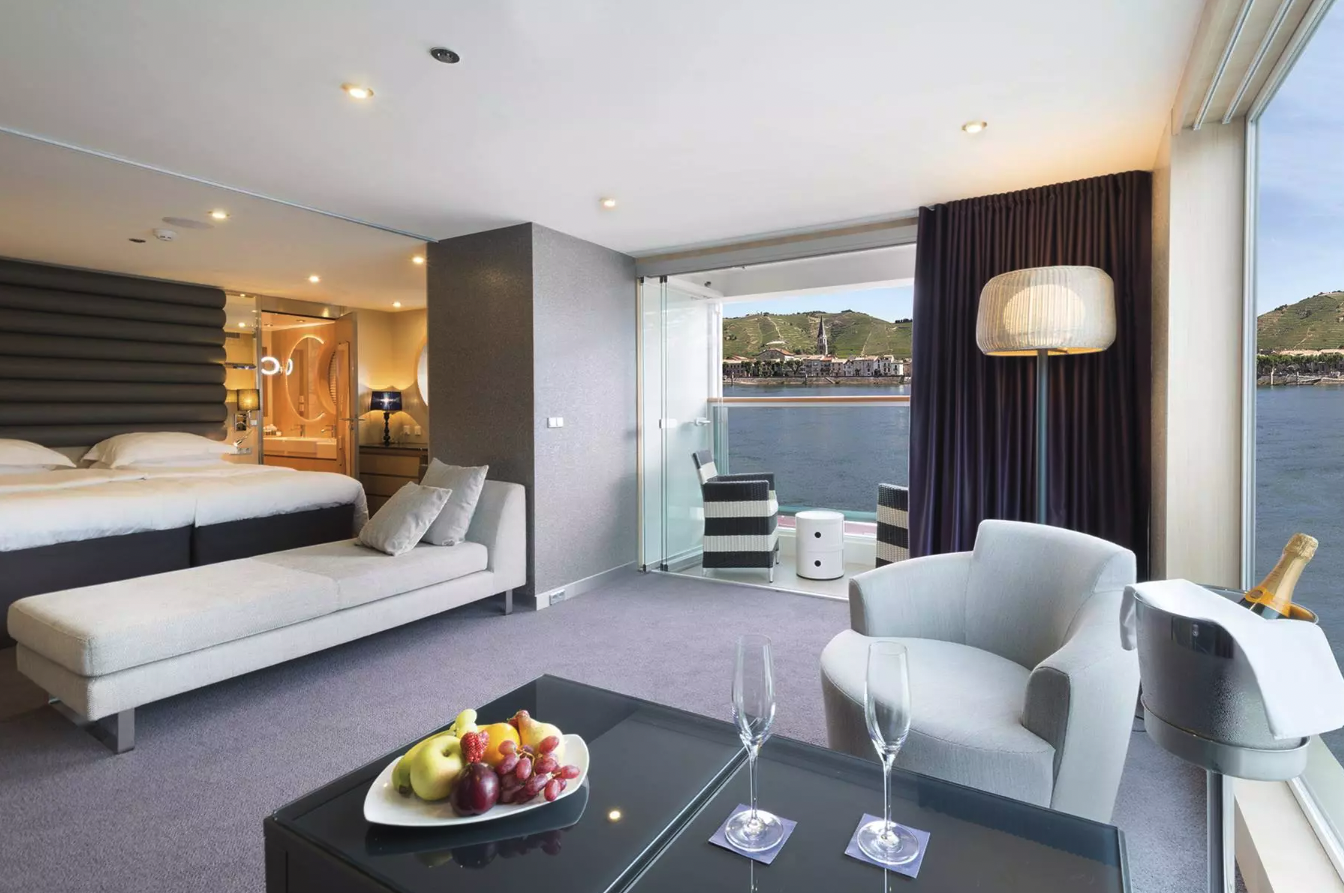
Royal One Bedroom Suite
At 455ft², these are amongst the largest suites on Europe’s rivers. At the rear of the Diamond Deck, enjoy fantastic views of the passing scenery, separate lounge and dining area and luxurious oversized bathroom.
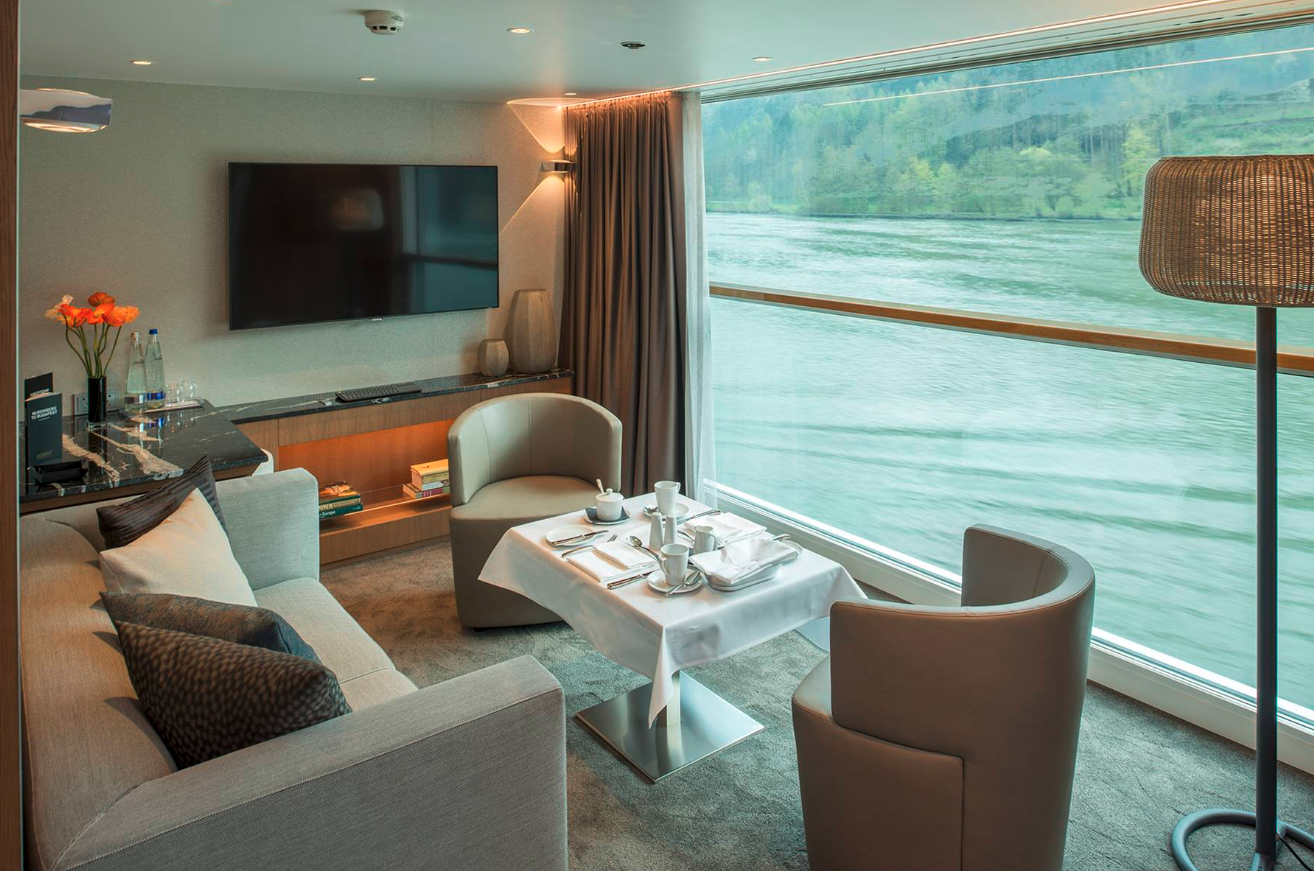
Royal Balcony Suite
These Suites located on the Diamond Deck are the ultimate in luxury with more space, impeccable service, thoughtful touches, an outdoor balcony, lounge area and an oversized bathroom.
Suite Highlights
- A luxury queen sized Scenic Slumber Bed
- Scenic Sun Lounge, for wide-angle splendour at the press of a button
- Separate lounge area
- Oversized bathroom with separate shower and bath, and upgraded bathroom amenities
Amenities & Features
- Exclusive invitation to dine at Table La Rive or Table d’Or
- Priority reservations at selected dining venues
- A complimentary welcome bottle of champagne (750ml)
- €200 per suite on board credit for use in the Wellness Centre
- Private arrival and departure transfers in Europe*
- Personalised butler service, including unlimited complimentary laundry, shoeshine and valet, early morning tea and coffee services and a daily delivery of savoury and sweet canapés or fruit
- Mini bar, replenished daily
- Pillow menu, including anti-aging, low-allergy and memory-foam neck pillows
- Nightly turndown service
- Bathrobes and slippers
- In-suite safe
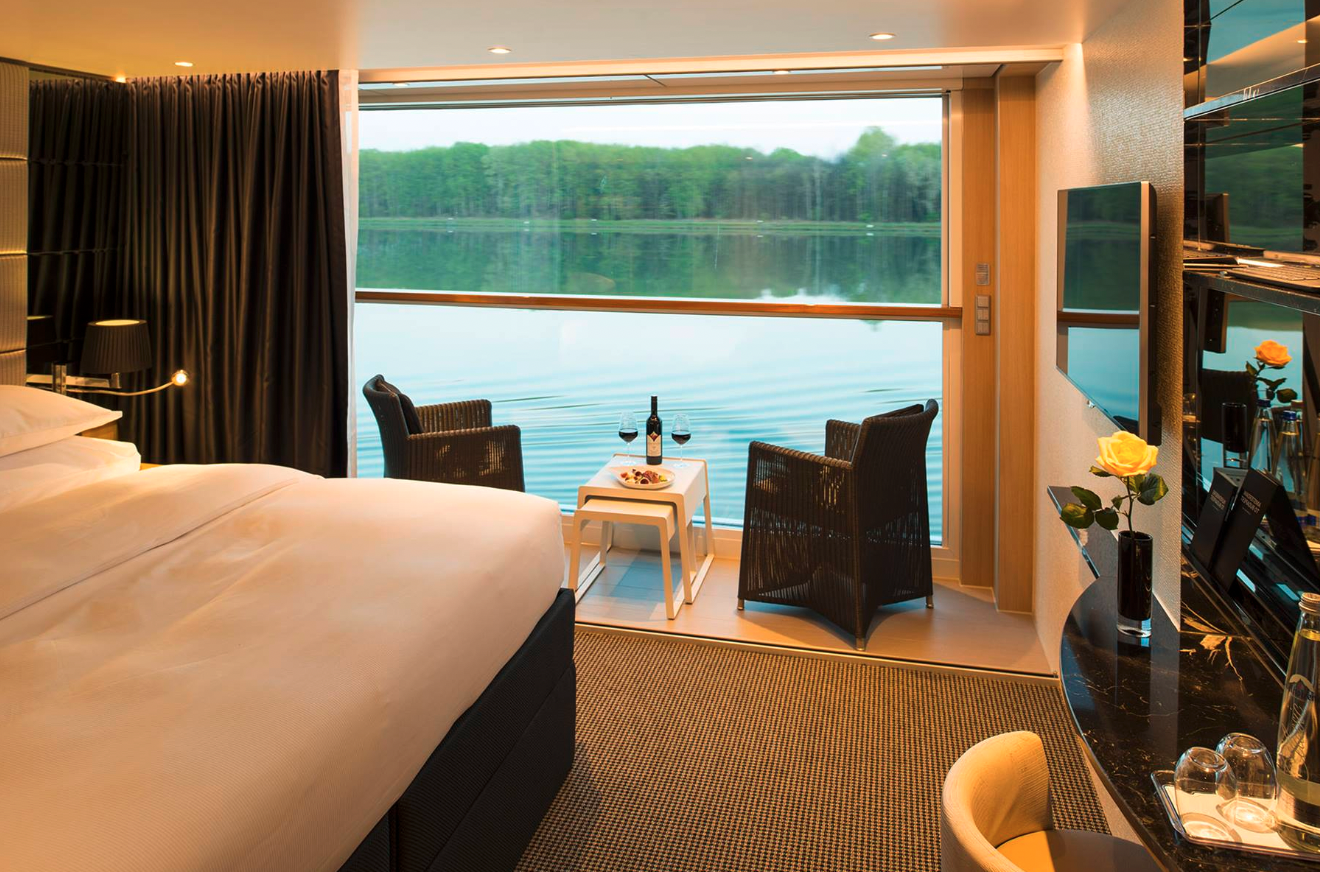
Deluxe Balcony Suite
Located in prime locations at the front of the ship on both the Sapphire and Diamond Decks, they offer all the features of our private Balcony Suites with our ingenious Scenic Sun Lounge, but with even more space to relax.
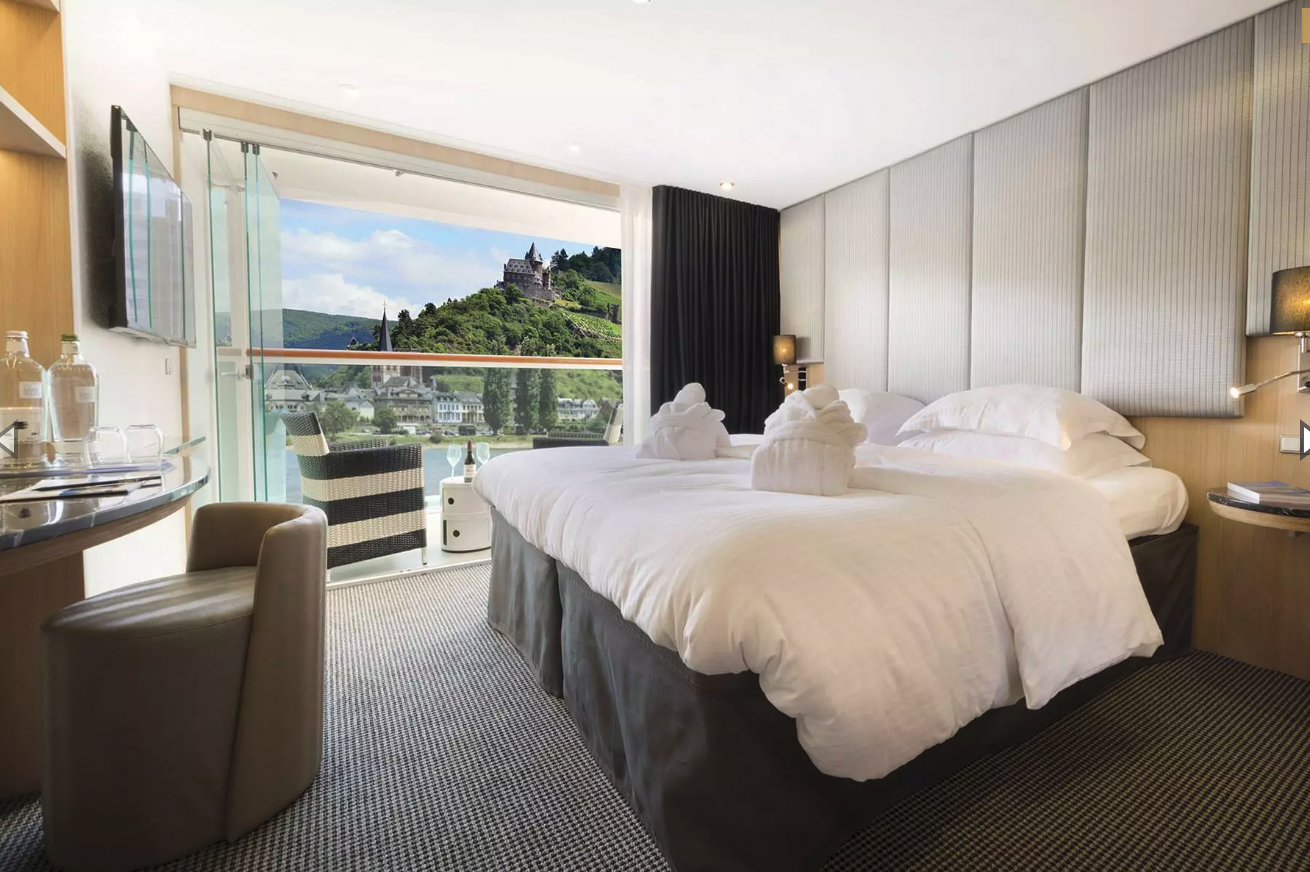
Balcony Suite
Located on the Sapphire and Diamond Decks these stylishly decorated suites feature a full-length outdoor balcony with the exclusive Scenic Sun Lounge and offer private bathrooms with a luxurious vanity basin and shower.
Room Highlights
- A luxury queen sized Scenic Slumber Bed
- Scenic Sun Lounge, for wide-angle splendour at the press of a button
- Spacious bathroom with luxurious amenities
Amenities & Features
- Personalised butler service for every suite
- Complimentary laundry service once per suite
- Early morning tea and coffee
- Beverage service in your suite
- Mini bar, replenished daily
- Pillow menu, including anti-aging, low-allergy and memory-foam neck pillows
- Nightly turndown service
- Bathrobes and slippers
- In-suite safe
- Shoeshine and valet service.
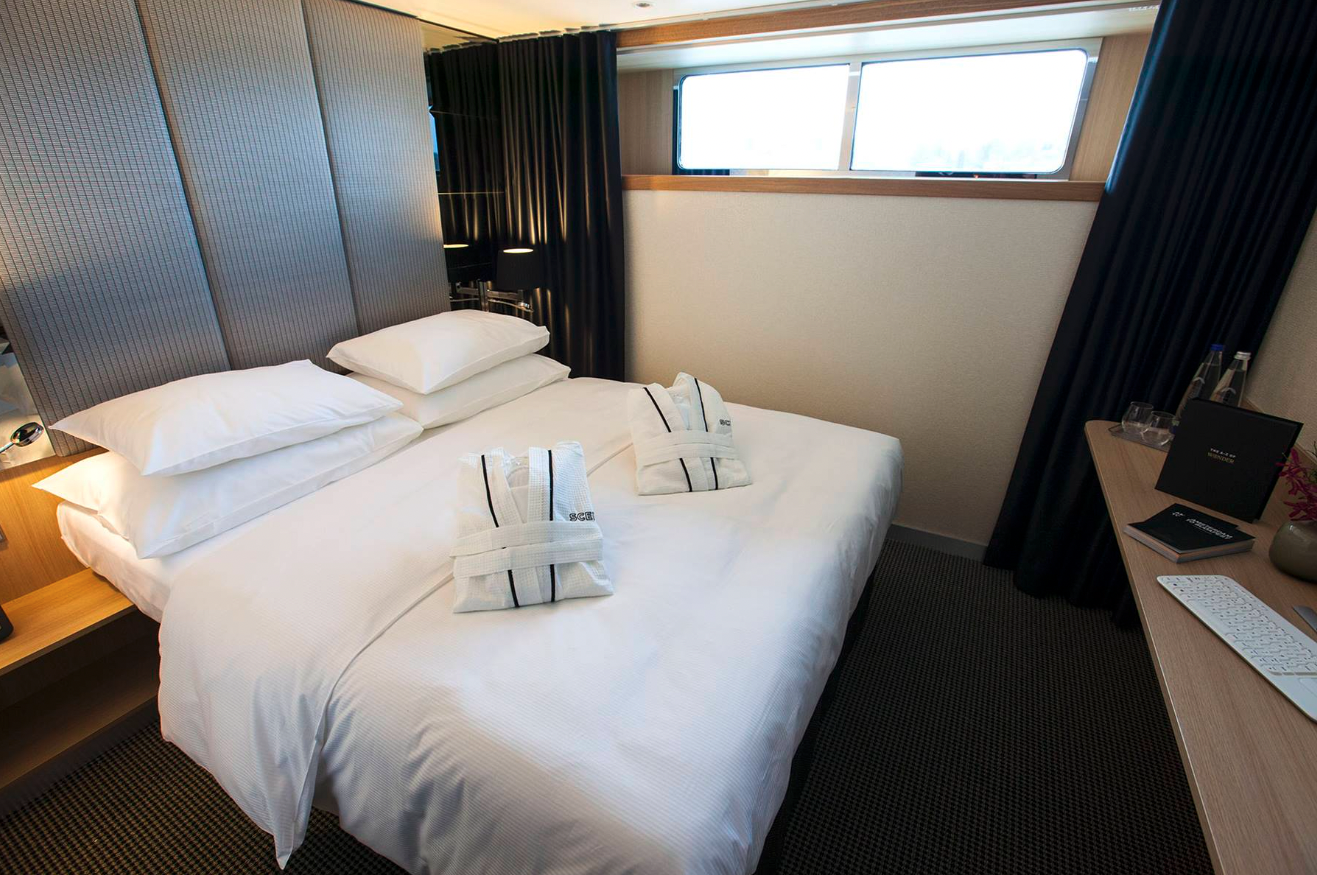
Standard Suite
Staterooms are located on the Jewel Deck with large picture windows to ensure a great view. They have a spacious design and clever layout alongside all the usual luxurious amenities and furnishings.
The bedroom area has a Queen-size Scenic ‘Slumber bed’ with Egyptian cotton linen and pillow menu. The bathroom with shower, is well stocked with L’Occitaine toiletries as well as a hairdryer, bathrobes and slippers. The suite also contains a complimentary in-suite mini-bar, restocked daily. The suite has a Flat screen HDTV linked to Mac Mini, complementary WiFi and use of a telephone. A safe is also provided for your valuables.
Guests staying within this suite receive butler service that includes valet and shoeshine service, drinks and cocktails.
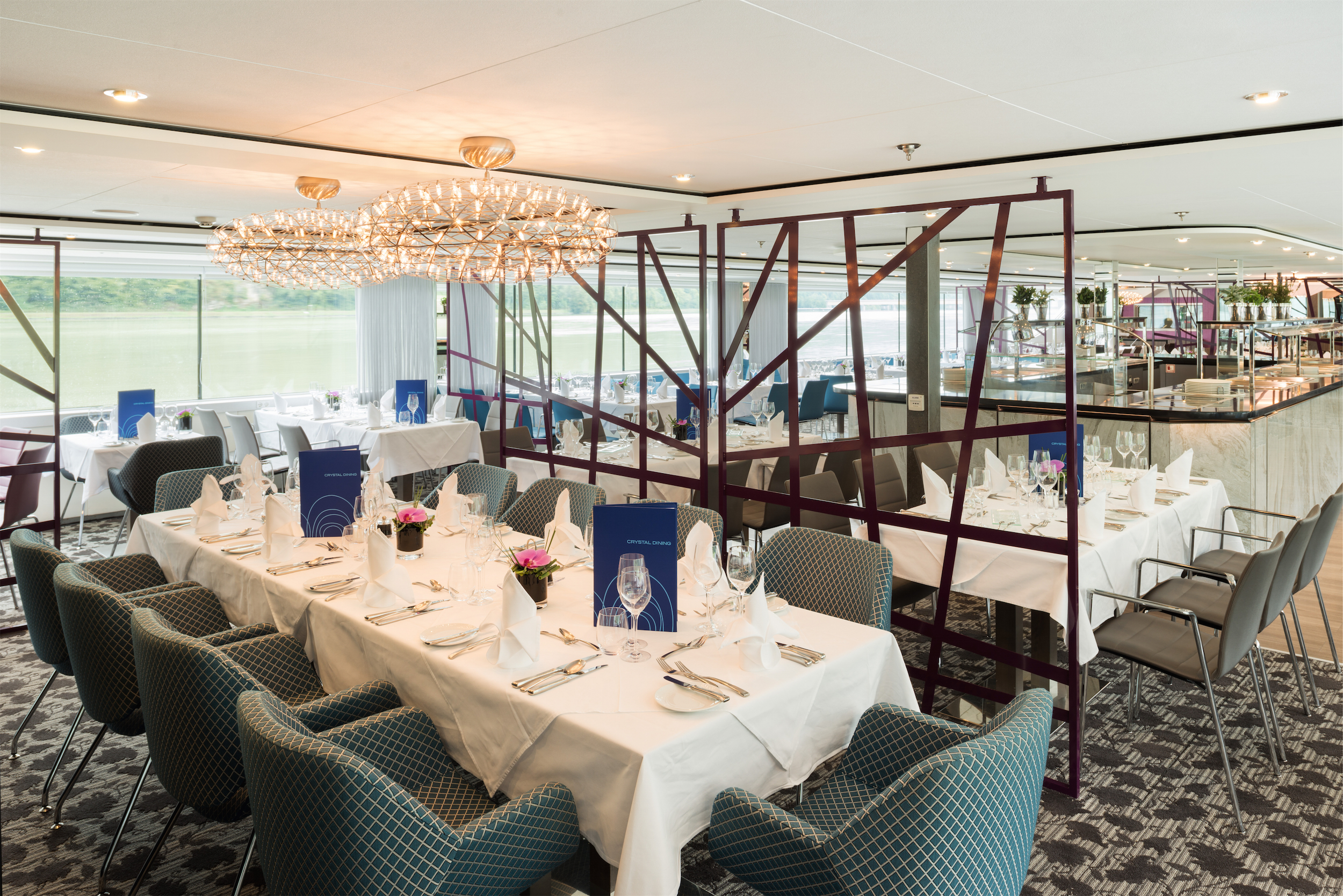
Crystal Dining
Enjoy à la carte menus for breakfast, lunch and dinner at Crystal Dining. Available on all Europe and South East Asia river cruises, this main restaurant offers a relaxed dining experience with local delicacies.
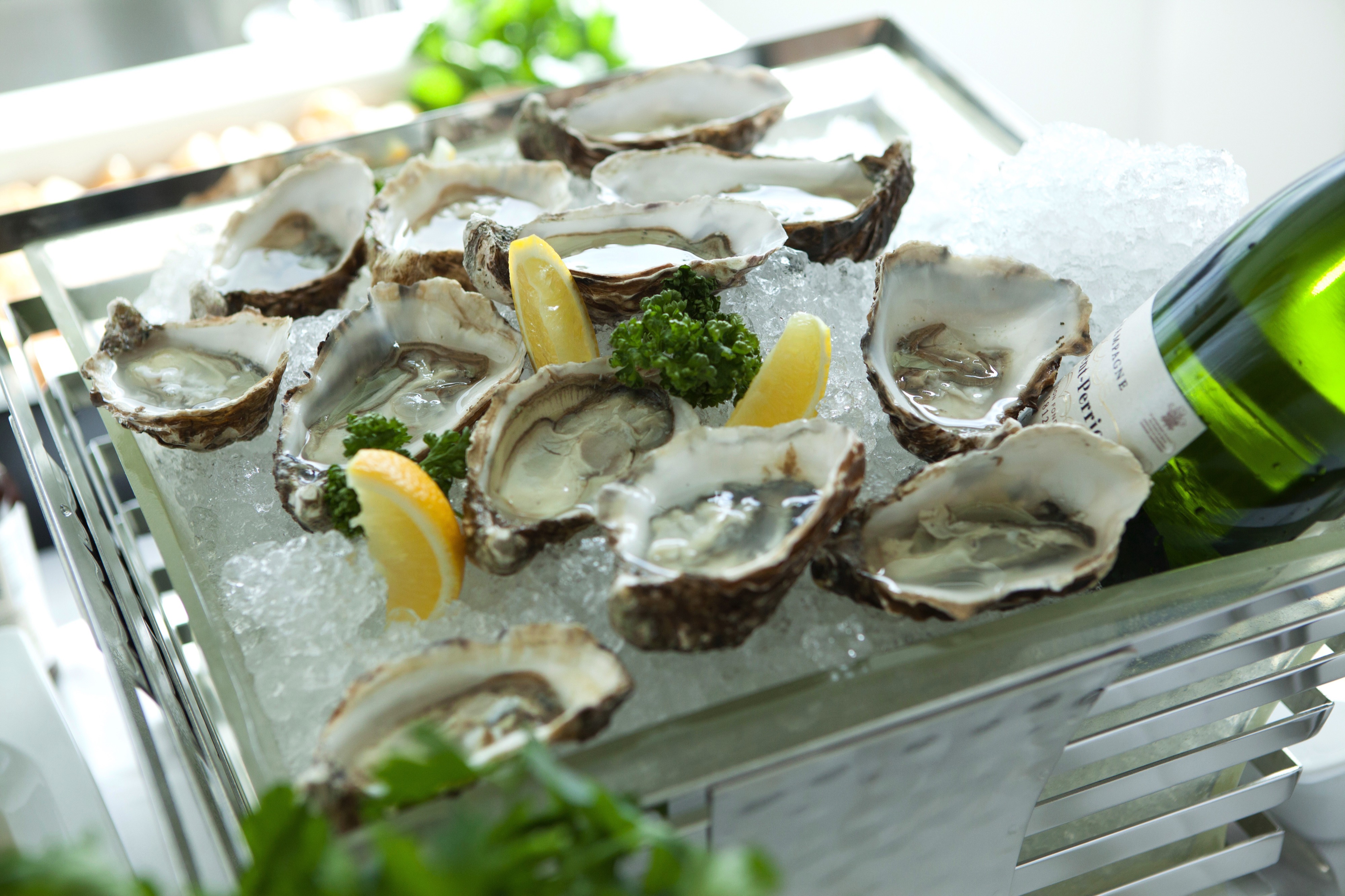
L'Amour Restaurant
With up to only 32 guests an evening, the exclusive and intimate Portobellos or L’Amour showcase sumptuous regional specialities. The delectable five-course menu features either Italian, French or Portuguese cuisine (depending on your cruise location), paired with elegant wines, and is available on all European river cruises.
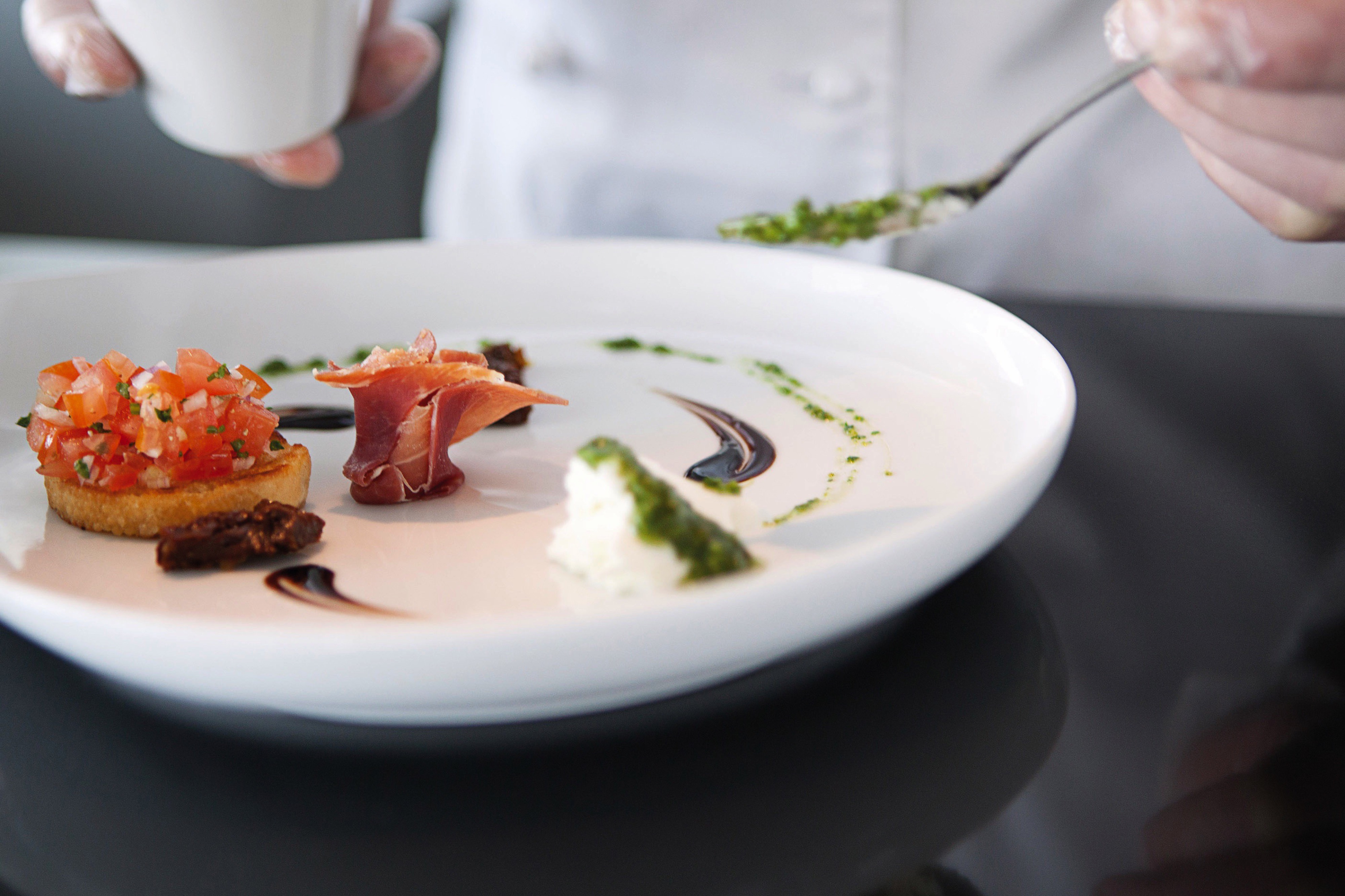
Table La Rive
Featuring a six-course degustation, the exclusive Table La Rive and Table d’Or on our European river cruises offers an intimate dining experience for only 10 guests per evening. Guests staying on the Diamond Deck for 10 nights or longer, as well as Royal and Junior Suite guests staying for up to nine nights, will be invited by our Executive Chef.
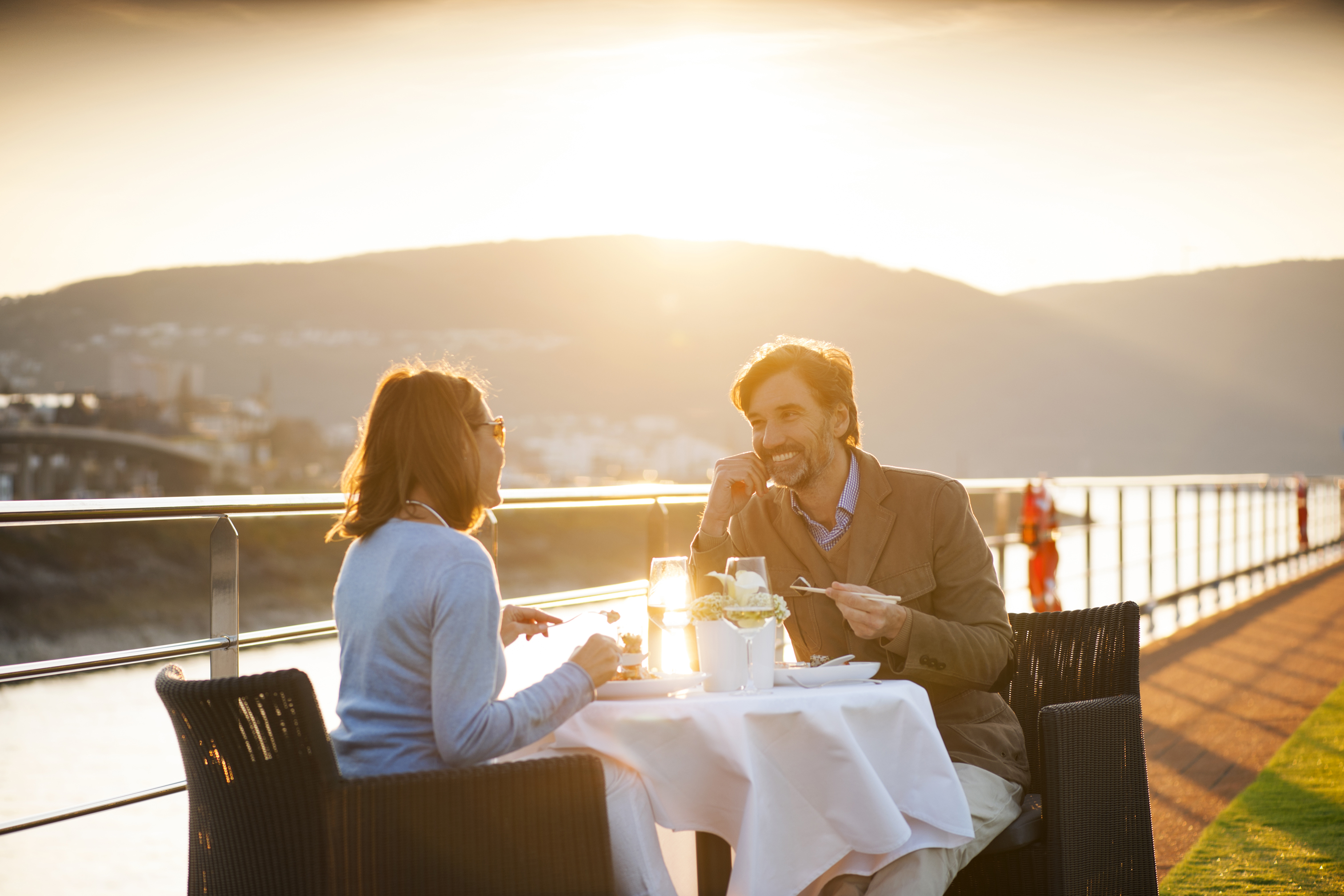
Riverview Terrace
Enjoy a refreshing afternoon aperitif or pick-me-up light bite on the Riverview Terrace, an open-air lounge and bar area located on the Sun Deck. Alfresco living doesn’t get better, with all-inclusive refreshments to complement the rapturous views.

River Café
Offering a casual dining experience, you can enjoy all-day grazing options, light snacks and tasty treats to suit your schedule. The River Café is available on all Europe and South East Asia river cruises.

In-Suite Dining
Choose to dine in the comfort of your luxurious suite, while taking in the incredible views and enjoy included room service throughout your cruise.
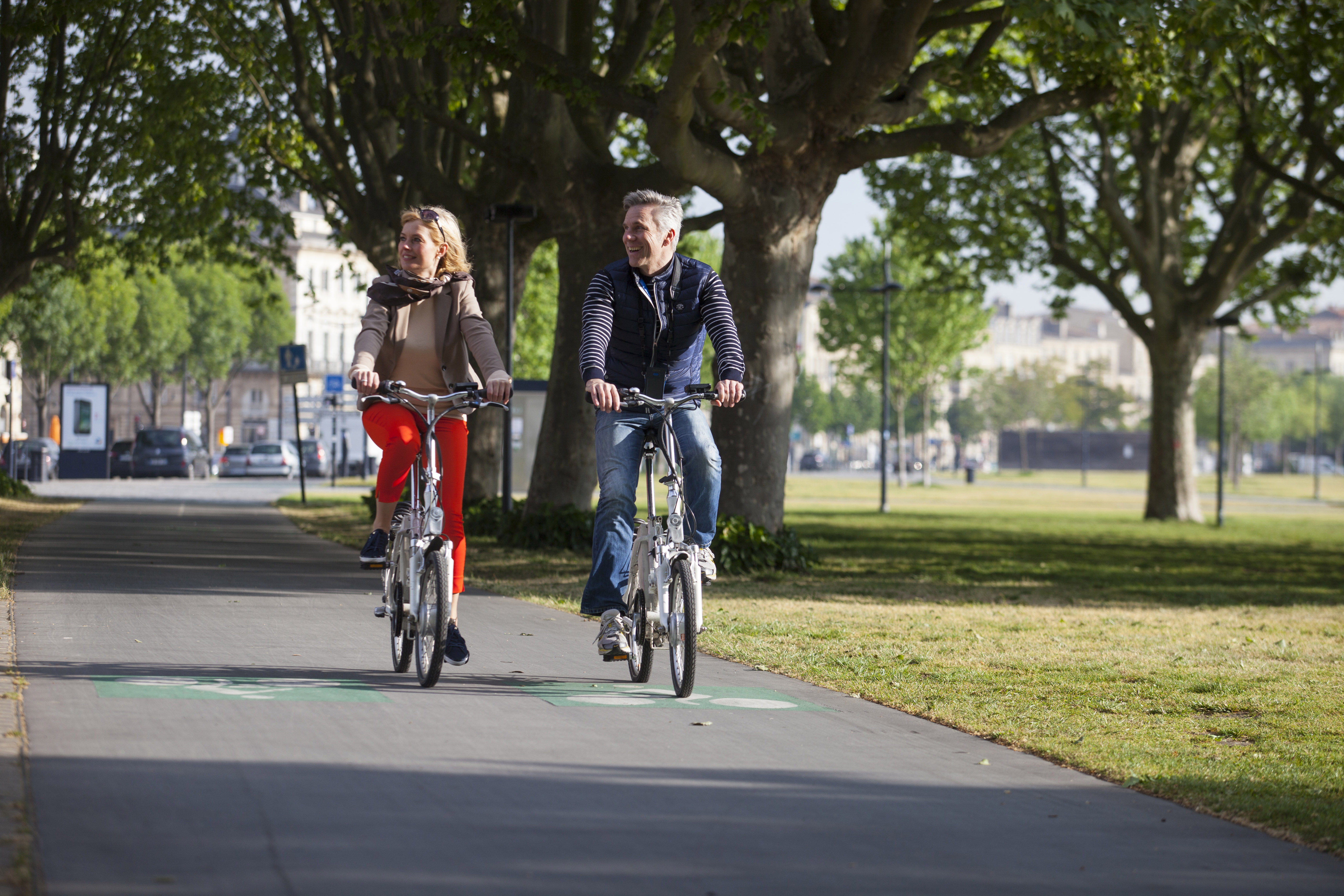
Scenic E-Bikes
Explore cities onshore on our complimentary e-bikes. Keep active and interact with locals as you explore Europe’s countryside.

Scenic Freechoice
Enjoy the freedom of customising your holiday your way with Scenic Freechoice. Choose from a wide range of truly all-inclusive experiences classified into ‘Active’, ‘Moderate’, and ‘Relaxed’ grades, and find the ones to match your pace each day.
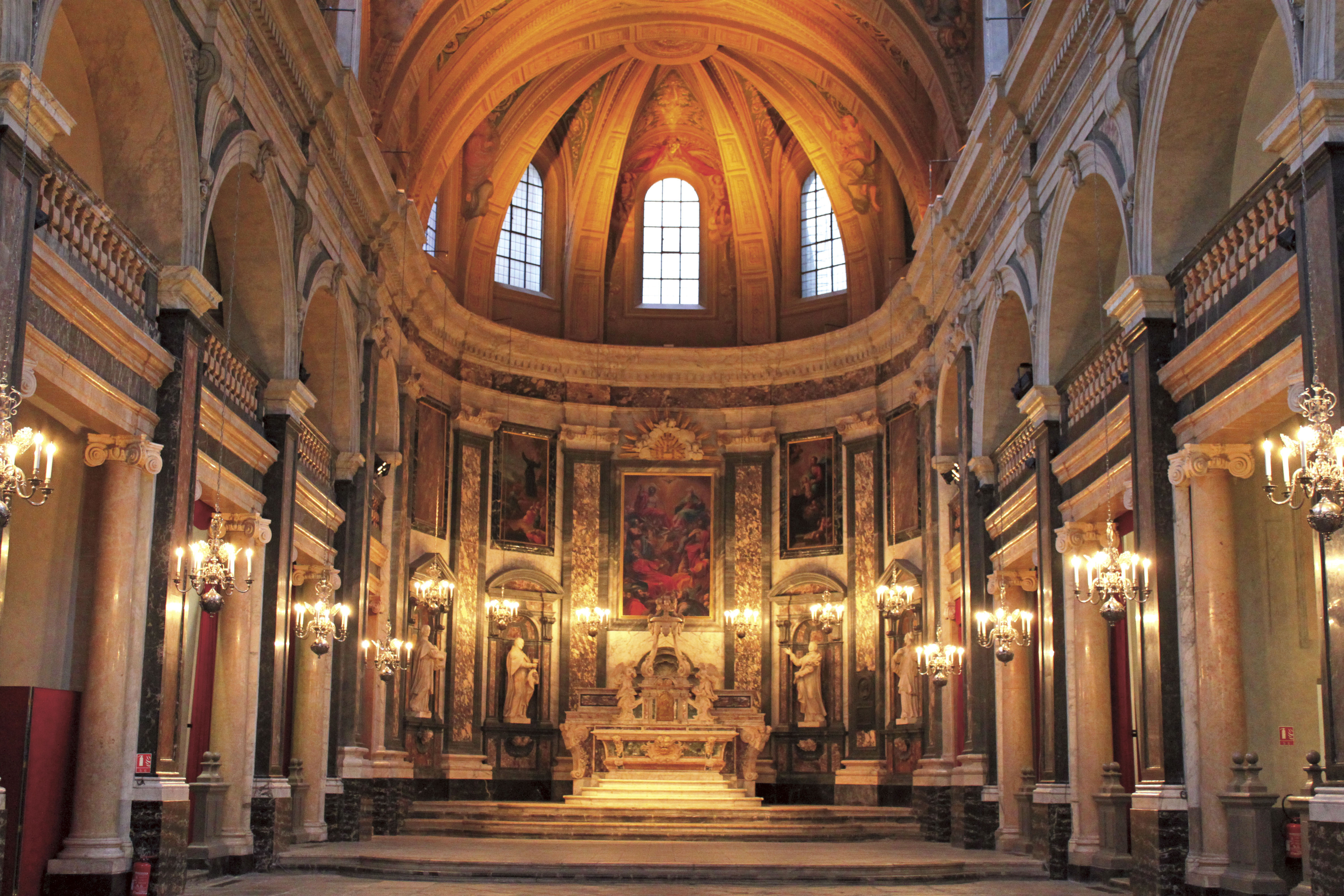
Scenic Enrich
Enjoy wondrous moments exclusively created for you, ranging from a private concert in a grand 18th century palace in Germany or indulging in a sumptuous dinner in a local home in the Netherlands. Enjoy these exquisite handcrafted experiences that are not available to the regular traveller.
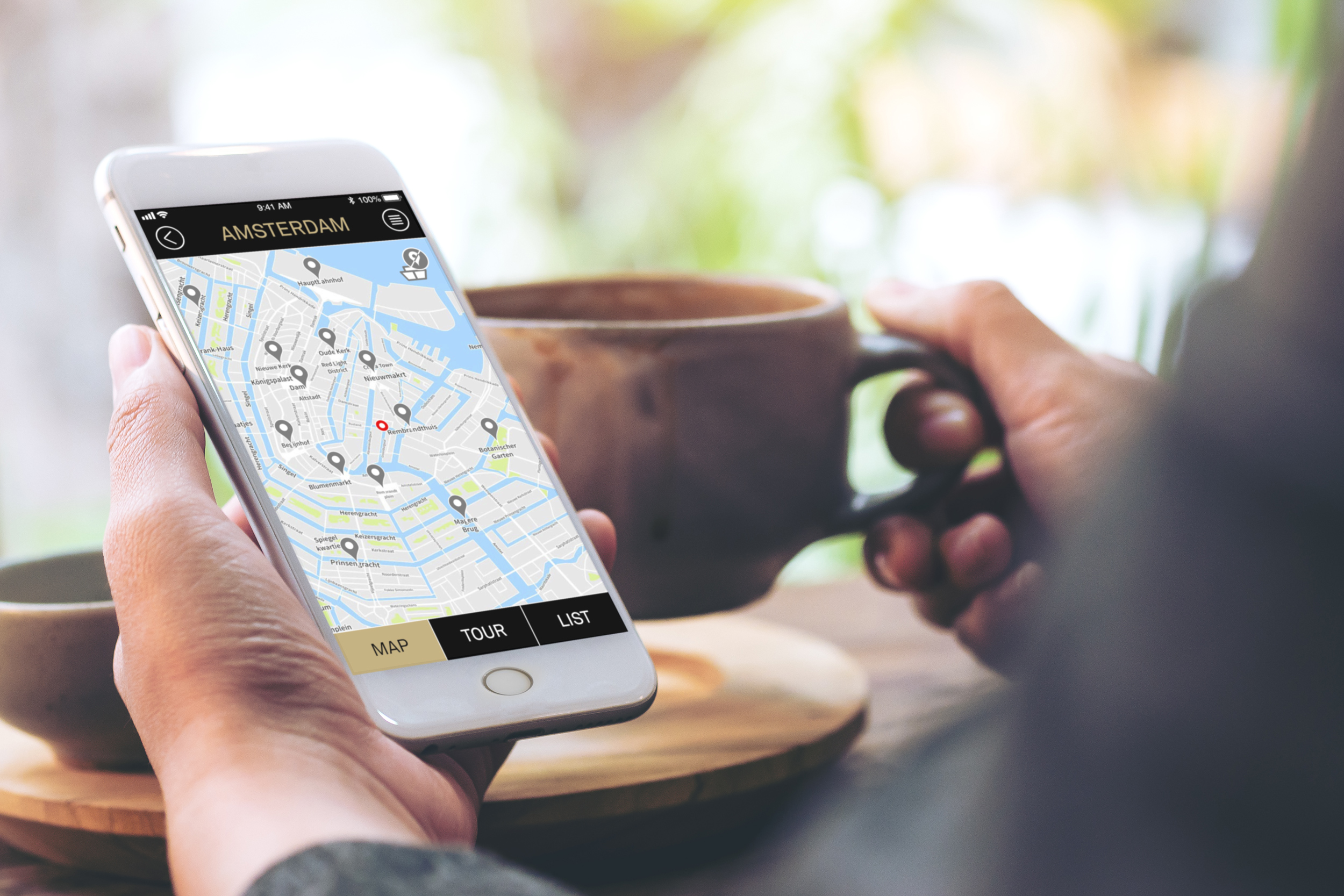
Scenic Tailormade
Immerse in the wonders of Europe with Scenic Tailormade, a GPS-powered discovery system, which can be downloaded from The App Store or Google Play, lets you see more of the continent both on board and on shore.
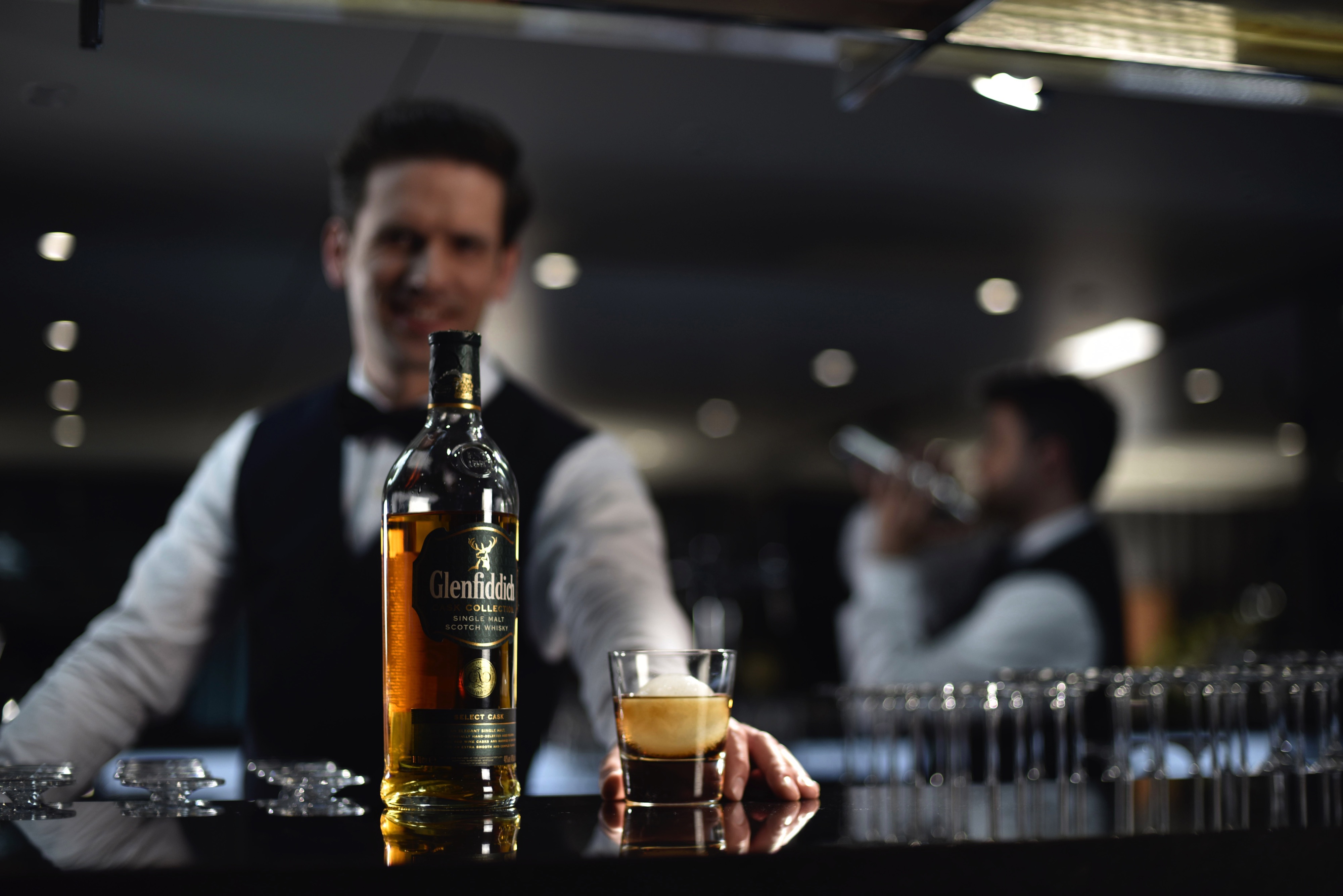
Panorama Lounge & Bar
The Panorama Lounge is the main bar area on board the Scenic Pearl. Here, you can explore our extensive bar menu, which is complete with premium wines, beers and spirits, whilst enjoying a programme of entertainment from local musicians, dancers and performers.
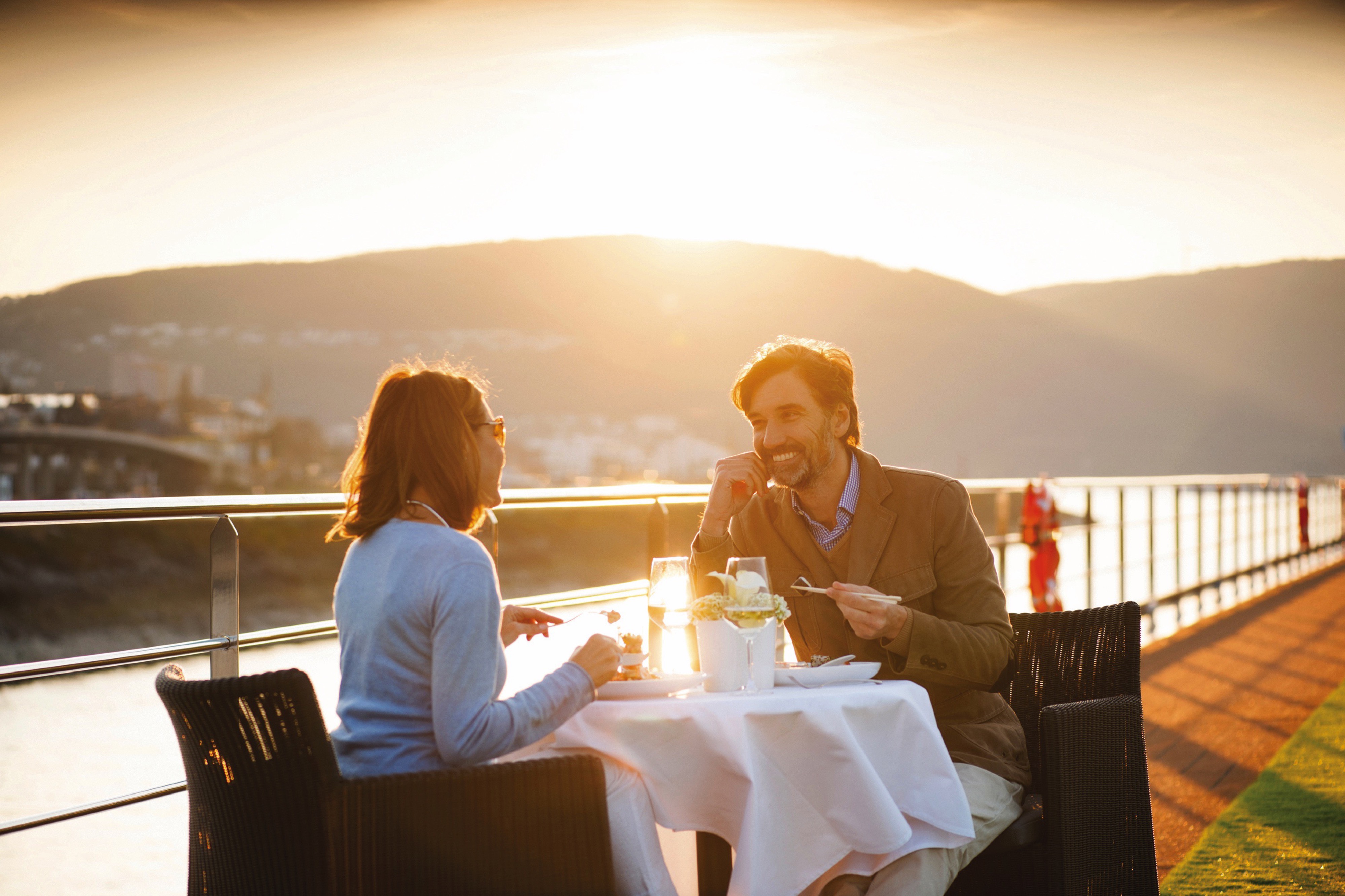
The Sun Deck
Ideal for those sunlit days on the river, the Sun Deck is a designated open-air space equipped with everything you might need to relax and enjoy the great outdoors on your river cruise – think deck chairs, games area and a bar where you can make the most of our all-inclusive service.
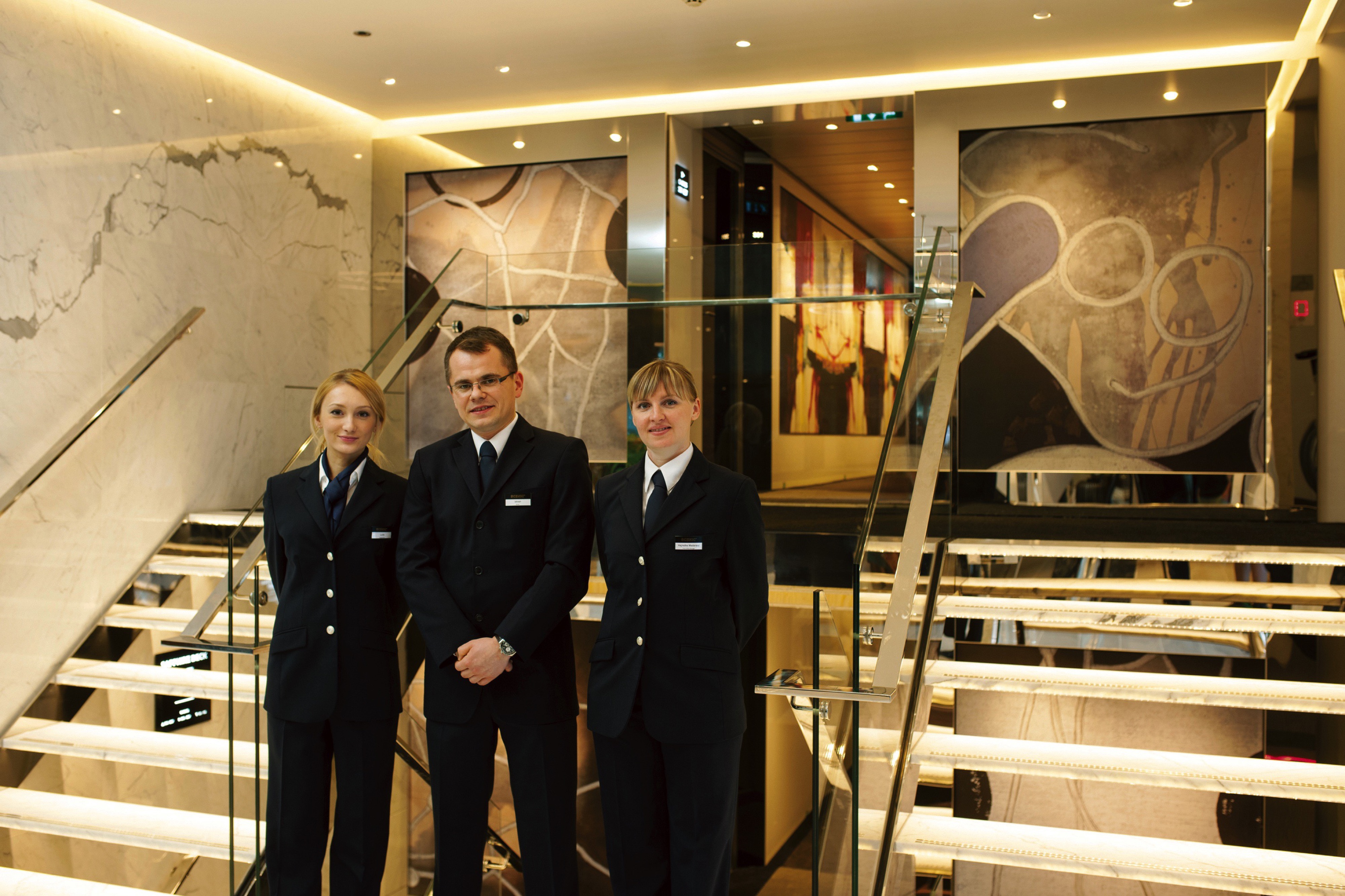
Reception
Whatever you need on your cruise through Europe, our welcoming reception team is here to ensure your trip goes down without a hitch. The reception area is also the meeting point for the day’s shore excursions; you’ll find it in the middle of the Scenic Gem.

Wheelhouse
The Wheelhouse is where our expert crew pilot your Space-Ship, negotiating the twists and turns of the Danube with the utmost precision and care. Stop by to chat with the team and take a peek behind the scenes.

Gallery
Our Gallery spaces are dedicated to showcasing works by local artists, so you feel connected to people and place in every destination. We believe little touches like this are what make our European river cruises so special.
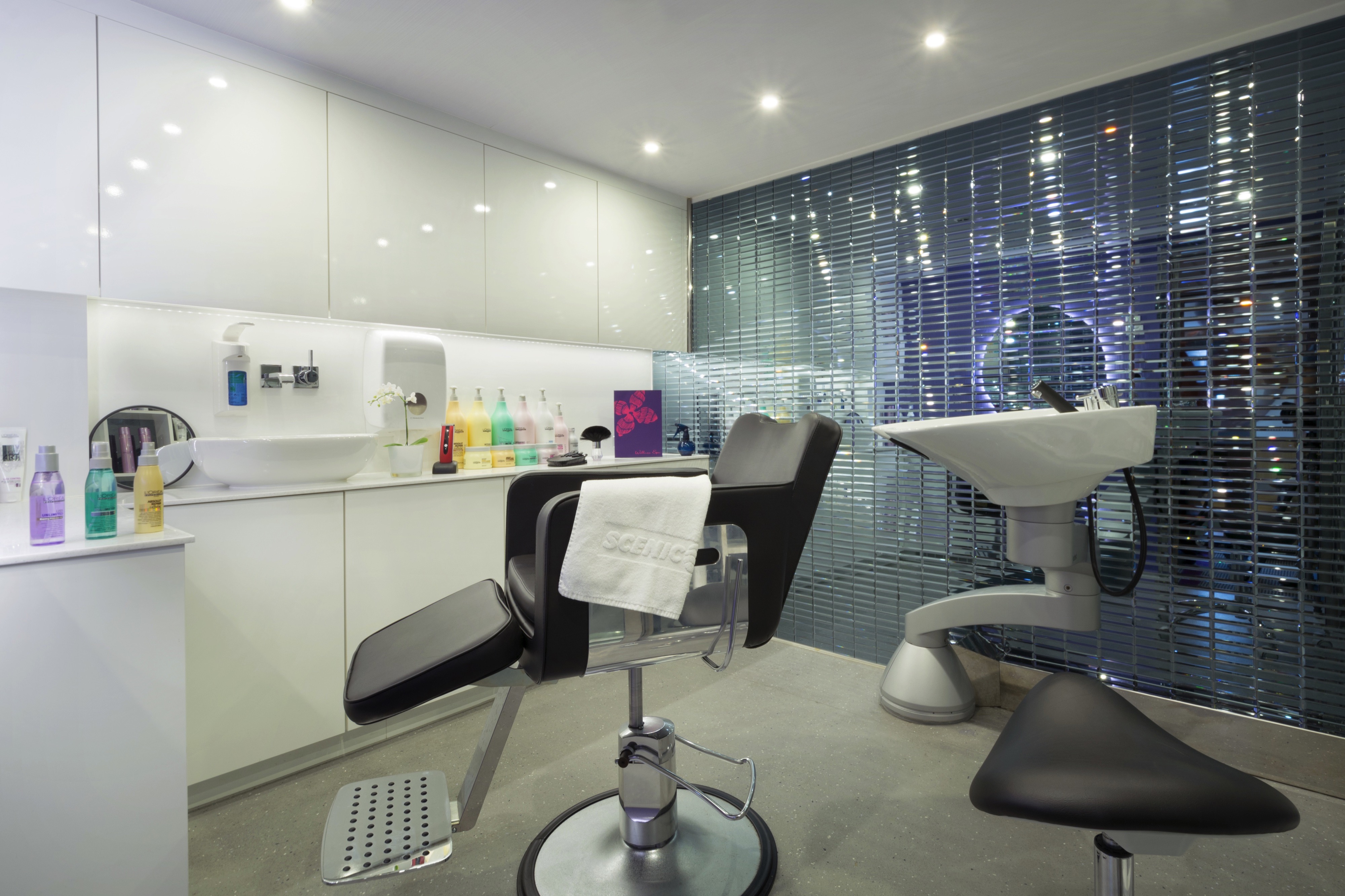
Wellness Area
Feel pampered throughout your river cruise at the Wellness Area. From facials to massages, our beauty therapist provides a selection of indulgent treatments to help you truly relax.
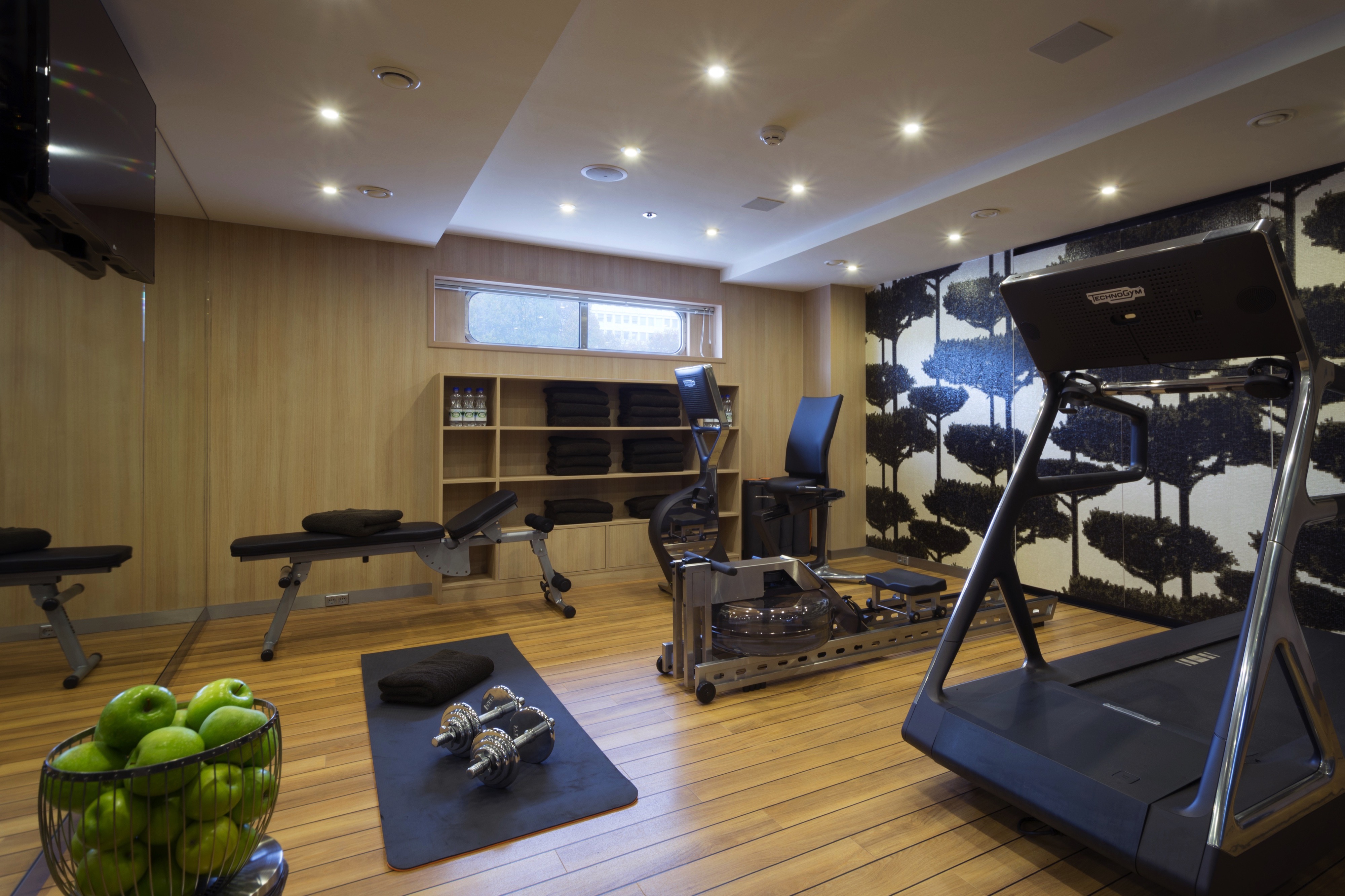
Fitness Centre
This innovative lounge is featured on most of our Space-Ships in Europe. The salt brick walls of the humidity and temperature-controlled lounge are known to offer a range of health benefits for respiratory and immune systems.
Dress Code
When you are relaxing on board, the dress code is smart casual and comfortable. Do not forget your swimsuits and exercise attire for the heated pools and plunge pools, the wellness areas and the gym, yoga and Pilates studio.
For evenings, while there are no formal nights, the recommended on board dress code is elegant casual for most restaurants. Suggested attire for women includes a dress, skirt or trousers with a sweater or blouse, and for men, trousers and a collared shirt. A tie and jacket are optional, but not required.
Age Restriction
Travellers who are less than 21 years old on the departure date must be accompanied by and share a cabin/ room with an adult aged 21 or over. Children under 12 years of age are not accepted. This is a condition of carriers and cruise operators.
Dietary Requirements
Scenic accommodates special dietary requirements to the best of our ability across our river cruises, ocean voyages and land journeys where applicable. If you have special dietary requests, please notify us at the time of booking and inform your Cruise Director when you arrive.
Please note: while we endeavour to accommodate all dietary requirements, special requests are not guaranteed and failure to meet any request is not a breach of contract on our behalf.
Wi-Fi
Complimentary internet facilities are available and Wi-Fi is accessible throughout the ship for your personal electronic devices. We cannot guarantee the availability or quality of the internet connections as this may vary according to destination and weather. Please note service will be limited in Polar and remote regions. Some sites also may not be accessible due to Scenic firewall/company protection.
Medical Facilities
Scenic Space-Ships do not carry medical personnel on board and immediate medical attention cannot always be guaranteed. However, our staff are trained in first aid, and can provide basic medical assistance. Should you need to call medical services, this will be at your own expense. Please be aware that we cannot provide personal escorts for medical visits.
Smoking Policy
Smoking is not permitted in suites or any other indoor area across the Scenic fleet.
Smoking is permitted in specific areas of external decks. However, we cannot guarantee that these facilities will always be available.
Packing Tips
There are no specific pieces of clothing we insist you pack, however we can offer pieces of advice, based upon your itinerary. We recommend comfortable walking shoes for sightseeing, as well as any garments, such as hats, gloves and water-resistant jackets, which will help you to stay comfortable whatever the weather. The dress code across all Scenic cruise and tour itineraries is casual and comfortable. Dinner attire is smart casual — open-neck shirts, trousers and dresses; you may wear a jacket or blazer with a tie but it is not required.
You are allowed to carry whatever prescription medication you require, and we’d recommend packing an ample supply that covers the duration of your cruise or tour. Due to strict drug laws in certain countries, make sure medication is carried in its original packaging with the prescription label clearly marked. When travelling through airports or border crossings, we’d recommend that you keep medication in your hand luggage ready for inspection.
Languages
The on board language is English. All staff, crew and tour guides speak English, and all announcements and lectures will be made in English.
Truly All-Inclusive Onshore Experiences
Scenic Enrich | Enjoy wondrous moments exclusively created for you, ranging from a private concert in a grand 18th century palace in Germany or indulging in a sumptuous dinner in a local home in the Netherlands. Enjoy these exquisite handcrafted experiences that are not available to the regular traveller.
Scenic Freechoice | Enjoy the freedom of customising your holiday your way with Scenic Freechoice. Choose from a wide range of truly all-inclusive experiences classified into ‘Active’, ‘Moderate’, and ‘Relaxed’ grades, and find the ones to match your pace each day.
Expert Local Guides | Nobody knows a place like those who live there. Explore the highlights and the hidden gems of your destination through the expert and passionate eyes of a local and take comfort in knowing you’re in good hands.
E-bikes | Enjoy the flexibility of our electrically-assisted bikes to explore your destination with minimal pedalling.
Scenic Tailormade App | Our exclusive app is the perfect accessory for independent exploration. Select between CityTour and Riverview modes to enjoy effortless self-guided touring.
Return Airport Transfers | Enjoy seamless included return airport transfer at the end of your trip.
The Scenic Space-Ship Experience
Spacious Suites | Scenic Space-Ship suites offer you the luxury of space. Our suites are some of the largest on Europe’s rivers. Relax in the signature Scenic Sun Lounge providing you with your very own window to the world in all our Balcony Suites.
Up to five dining options | With an array of dining options, you can sample new cuisines and a different meal each day on your relaxing river cruise. From casual to fine dining, you will experience fresh local produce and a taste sensation for every occasion.
Complimentary beverages | Whether relaxing by the pool accompanied by a refreshing cocktail, or a nightcap for a good night’s sleep, enjoy our range of unlimited complimentary premium beverages all day, every day.
Butler service | Need your shoes shined, breakfast sent to your suite or laundry done? Consider it done. Our all-day butler service will ensure you have everything you need for a relaxing holiday.
Complimentary mini-bar | The mini-bar in your room will be restocked daily with all your favourite alcoholic and non-alcoholic drinks and snacks, customisable to your taste.
Wellness area and fitness area | Stay in your best shape while on board with our fitness centre and wellness zone. Enjoy the healing benefits of the Salt Therapy Lounge known to improve respiratory conditions and immunity.
Cruise Director | Our expert Cruise Directors are your storyteller, historian, guide, and friend rolled into one. From helping you set up your Tailormade App to directing you to the nearest golf course, you can count them to address your every need.
Complimentary Wi-Fi | Stay in touch with your family and friends no matter where you set sail to with our complimentary on board Wi-Fi.
All tipping and gratuities | We’ve included all your tipping and gratuities for the entire cruise so you can lock away your wallet and simply enjoy the truly all-inclusive experience.
What's Included
All meals and drinks (with the exception of a selection of speciality wines and rare spirits) are included in the price of your Europe river cruise or Scenic Eclipse voyage.
Inclusions differ for land journeys and the land element of South East Asia river cruises. Selected meals and drinks are included. Please refer to the itinerary for full details.
Scenic E-Bike
If you’d like to use a Scenic e-bike, please notify the reception staff the day before. They will organise for the bikes to be unloaded when the ship enters port. Please note that Scenic e-bikes are not available, and are not available during Portugal cruises due to cycling path restrictions along the respective rivers.
Dining Times
Dining times may vary depending on the day’s activities, but are generally as follows:
- Breakfast: 7am – 9:30am
- Lunch: 12pm – 2pm
- Dinner: 7pm – 10pm
Please note: if a specific sightseeing excursion means you will miss a meal on board, speak to a member of staff and they will be happy to have a picnic box prepared for you before you depart.

Sun Deck
- Riverview Terrace
- Wheelhouse
- Sun Deck
- Walking Track

Diamond Deck
- Panorama Deck
- L’Amour Restaurant
- River Cafe
- Panorama Lounge & Bar
- Gift Shop
- Reception
- Elevator
- Royal One-Bedroom Suite Cat RP
- Royal Balcony Suite Cat R
- Deluxe Balcony Suite Cat PD
- Balcony Suite Cat P & PA

Sapphire Deck
- Crystal Dining Restaurant
- Table La Rive
- Galley
- Elevator
- Deluxe Balcony Suite Cat BD
- Balcony Suite Cat C

Jewell Deck
- Wellness Area
- Fitness Centre
- Standard Suite Cat E
